|
Search for electroweak production of supersymmetric states in scenarios with compressed mass spectra at $\sqrt{s}=13$ TeV with the ATLAS detector 21 December 2017 | |
| Contact: ATLAS SUSY conveners | |
| Content | Preview |
|---|---|
| e-print arXiv:1712.08119, Physics Briefing - internal | pdf from arXiv |
| Inspire record | - |
| Data points | - |
| Figures Tables Auxiliary Material | - |
| Abstract | |
| A search for electroweak production of supersymmetric particles in scenarios with compressed mass spectra in final states with two low-momentum leptons and missing transverse momentum is presented. This search uses proton-proton collision data recorded by the ATLAS detector at the Large Hadron Collider in 2015-2016, corresponding to 36.1 fb$^{-1}$ of integrated luminosity at $\sqrt{s}=13$ TeV. Events with same-flavor pairs of electrons or muons with opposite electric charge are selected. The data are found to be consistent with the Standard Model prediction. Results are interpreted using simplified models of R-parity-conserving supersymmetry in which there is a small mass difference between the masses of the produced supersymmetric particles and the lightest neutralino. Exclusion limits at 95% confidence level are set on next-to-lightest neutralino masses of up to 130 GeV for Higgsino production and 170 GeV for wino production, and sleptons masses of up to 180 GeV for pair production of sleptons. In the compressed mass regime, the exclusion limits extend down to mass splittings of 3 GeV for Higgsino production, 2.5 GeV for wino production, and 1 GeV for slepton production. The results are also interpreted in the context of a radiatively-driven natural supersymmetry model with non-universal Higgs boson masses. | |
| Figures | |
|
Figure 01a: Diagrams representing the two-lepton final state of (a) electroweakino χ̃20χ̃1± and (b) slepton pair ℓ̃ℓ̃ production in association with a jet radiated from the initial state (labeled j). The Higgsino simplified model also considers χ̃20χ̃10 and χ̃1+χ̃1- production. png (18kB) pdf (35kB) |
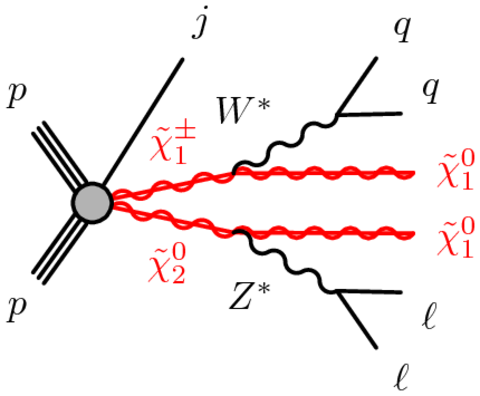 |
|
Figure 01b: Diagrams representing the two-lepton final state of (a) electroweakino χ̃20χ̃1± and (b) slepton pair ℓ̃ℓ̃ production in association with a jet radiated from the initial state (labeled j). The Higgsino simplified model also considers χ̃20χ̃10 and χ̃1+χ̃1- production. png (15kB) pdf (26kB) |
 |
|
Figure 02: Dilepton invariant mass (mℓℓ) for Higgsino (H̃) and wino--bino (W̃/B̃) simplified models. The endpoint of the mℓℓ distribution is determined by the difference between the masses of the χ̃20 and χ̃10. The results from simulation (solid) are compared with an analytic calculation of the expected lineshape (dashed), where the product of the signed mass eigenvalues (m(χ̃20)× m(χ̃10)) is negative for Higgsino and positive for wino--bino scenarios. png (57kB) pdf (16kB) |
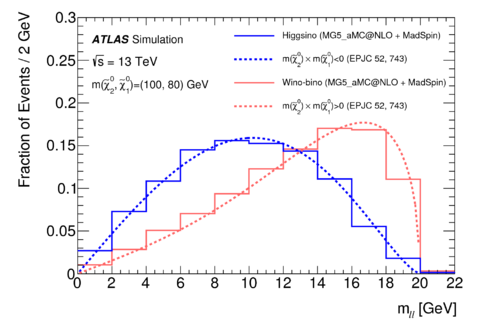 |
|
Figure 03a: Distributions of ETmiss/HTlep for the electroweakino (left) and slepton (right) SRs, after applying all signal region selection criteria except those on ETmiss/HTlep, mℓℓ, and mT2. The solid red line indicates the requirement applied in the signal region; events in the region below the red line are rejected. Representative benchmark signals for the Higgsino (left) and slepton (right) simplified models are shown as circles. Both signal and background are normalized to their expected yields in 36.1 fb-1. The total background includes the MC prediction for all the processes listed in Table 1 and a data-driven estimate for fake/nonprompt leptons discussed further in Section 6. png (210kB) pdf (55kB) |
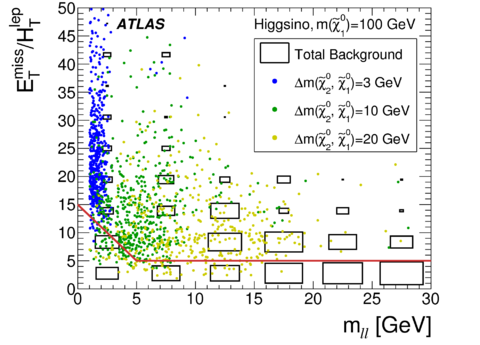 |
|
Figure 03b: Distributions of ETmiss/HTlep for the electroweakino (left) and slepton (right) SRs, after applying all signal region selection criteria except those on ETmiss/HTlep, mℓℓ, and mT2. The solid red line indicates the requirement applied in the signal region; events in the region below the red line are rejected. Representative benchmark signals for the Higgsino (left) and slepton (right) simplified models are shown as circles. Both signal and background are normalized to their expected yields in 36.1 fb-1. The total background includes the MC prediction for all the processes listed in Table 1 and a data-driven estimate for fake/nonprompt leptons discussed further in Section 6. png (160kB) pdf (39kB) |
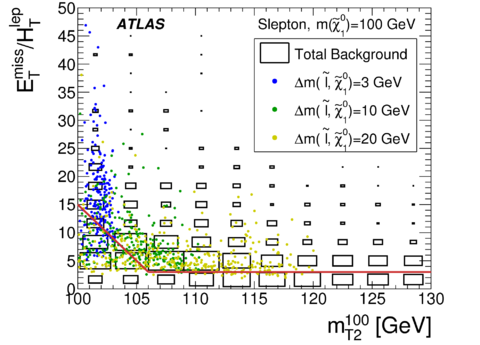 |
|
Figure 04a: Examples of kinematic distributions after the background-only fit showing the data as well as the expected background in control regions CR-tau (left) and CR-top (right). The full event selection of the corresponding regions is applied, except for the requirement that is imposed on the variable being plotted. This requirement is indicated by blue arrows in the distributions. The first (last) bin includes underflow (overflow). Background processes containing fewer than two prompt leptons are categorized as `Fake/nonprompt'. The category `Others' contains rare backgrounds from triboson, Higgs boson, and the remaining top-quark production processes listed in Table 1. The uncertainty bands plotted include all statistical and systematic uncertainties. png (100kB) pdf (19kB) |
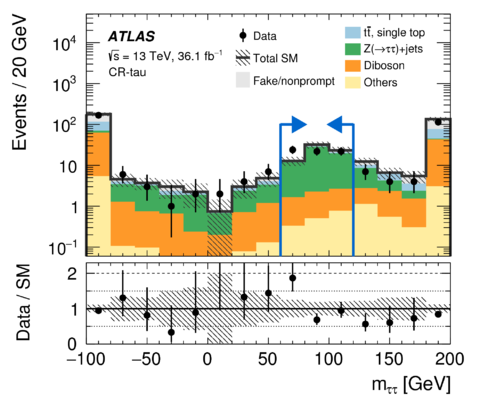 |
|
Figure 04b: Examples of kinematic distributions after the background-only fit showing the data as well as the expected background in control regions CR-tau (left) and CR-top (right). The full event selection of the corresponding regions is applied, except for the requirement that is imposed on the variable being plotted. This requirement is indicated by blue arrows in the distributions. The first (last) bin includes underflow (overflow). Background processes containing fewer than two prompt leptons are categorized as `Fake/nonprompt'. The category `Others' contains rare backgrounds from triboson, Higgs boson, and the remaining top-quark production processes listed in Table 1. The uncertainty bands plotted include all statistical and systematic uncertainties. png (107kB) pdf (21kB) |
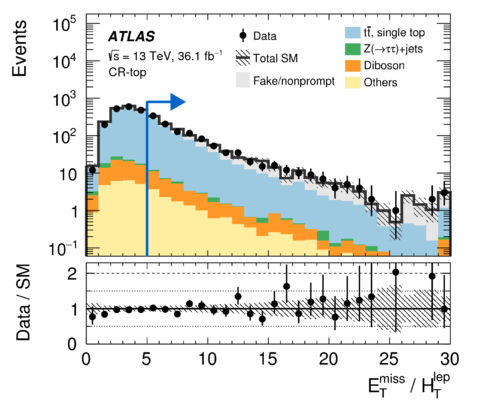 |
|
Figure 05a: The relative systematic uncertainties in the background prediction in the exclusive electroweakino (left) and slepton (right) SRs. The individual uncertainties can be correlated and do not necessarily add up in quadrature to the total uncertainty. png (64kB) pdf (14kB) |
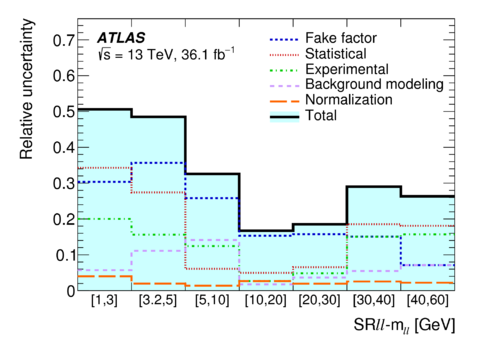 |
|
Figure 05b: The relative systematic uncertainties in the background prediction in the exclusive electroweakino (left) and slepton (right) SRs. The individual uncertainties can be correlated and do not necessarily add up in quadrature to the total uncertainty. png (39kB) pdf (14kB) |
 |
|
Figure 06: Comparison of observed and expected event yields in the validation regions after the background-only fit. Background processes containing fewer than two prompt leptons are categorized as `Fake/nonprompt'. The category `Others' contains rare backgrounds from triboson, Higgs boson, and the remaining top-quark production processes listed in Table 1. Uncertainties in the background estimates include both the statistical and systematic uncertainties, where σtot denotes the total uncertainty. png (27kB) pdf (20kB) |
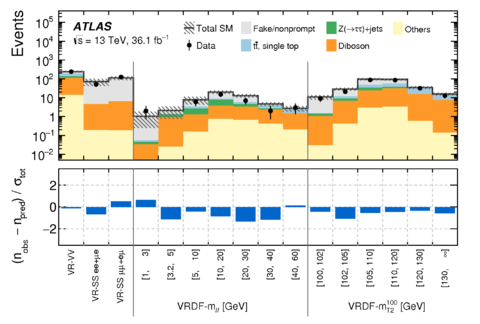 |
|
Figure 07a: Kinematic distributions after the background-only fit showing the data and the expected background in the different-flavor validation region VRDF-mT2100 (top left), the diboson validation region VR-VV (top right), and the same-sign validation region VR-SS inclusive of lepton flavor (bottom). Similar levels of agreement are observed in other kinematic distributions for VR-SS and VR-VV. Background processes containing fewer than two prompt leptons are categorized as `Fake/nonprompt'. The category `Others' contains rare backgrounds from triboson, Higgs boson, and the remaining top-quark production processes listed in Table 1. The last bin includes overflow. The uncertainty bands plotted include all statistical and systematic uncertainties. Orange arrows in the Data/SM panel indicate values that are beyond the y-axis range. png (92kB) pdf (18kB) |
 |
|
Figure 07b: Kinematic distributions after the background-only fit showing the data and the expected background in the different-flavor validation region VRDF-mT2100 (top left), the diboson validation region VR-VV (top right), and the same-sign validation region VR-SS inclusive of lepton flavor (bottom). Similar levels of agreement are observed in other kinematic distributions for VR-SS and VR-VV. Background processes containing fewer than two prompt leptons are categorized as `Fake/nonprompt'. The category `Others' contains rare backgrounds from triboson, Higgs boson, and the remaining top-quark production processes listed in Table 1. The last bin includes overflow. The uncertainty bands plotted include all statistical and systematic uncertainties. Orange arrows in the Data/SM panel indicate values that are beyond the y-axis range. png (98kB) pdf (20kB) |
 |
|
Figure 07c: Kinematic distributions after the background-only fit showing the data and the expected background in the different-flavor validation region VRDF-mT2100 (top left), the diboson validation region VR-VV (top right), and the same-sign validation region VR-SS inclusive of lepton flavor (bottom). Similar levels of agreement are observed in other kinematic distributions for VR-SS and VR-VV. Background processes containing fewer than two prompt leptons are categorized as `Fake/nonprompt'. The category `Others' contains rare backgrounds from triboson, Higgs boson, and the remaining top-quark production processes listed in Table 1. The last bin includes overflow. The uncertainty bands plotted include all statistical and systematic uncertainties. Orange arrows in the Data/SM panel indicate values that are beyond the y-axis range. png (49kB) pdf (17kB) |
 |
|
Figure 07d: Kinematic distributions after the background-only fit showing the data and the expected background in the different-flavor validation region VRDF-mT2100 (top left), the diboson validation region VR-VV (top right), and the same-sign validation region VR-SS inclusive of lepton flavor (bottom). Similar levels of agreement are observed in other kinematic distributions for VR-SS and VR-VV. Background processes containing fewer than two prompt leptons are categorized as `Fake/nonprompt'. The category `Others' contains rare backgrounds from triboson, Higgs boson, and the remaining top-quark production processes listed in Table 1. The last bin includes overflow. The uncertainty bands plotted include all statistical and systematic uncertainties. Orange arrows in the Data/SM panel indicate values that are beyond the y-axis range. png (47kB) pdf (18kB) |
 |
|
Figure 08a: Kinematic distributions after the background-only fit showing the data as well as the expected background in the inclusive electroweakino SRℓℓ-mℓℓ [1, 60] (top) and slepton SRℓℓ-mT2100 [100, ∞] (bottom) signal regions. The arrow in the ETmiss/HTlep variables indicates the minimum value of the requirement imposed in the final SR selection. The mℓℓ and mT2 distributions (right) have all the SR requirements applied. Background processes containing fewer than two prompt leptons are categorized as `Fake/nonprompt'. The category `Others' contains rare backgrounds from triboson, Higgs boson, and the remaining top-quark production processes listed in Table 1. The uncertainty bands plotted include all statistical and systematic uncertainties. The last bin includes overflow. The dashed lines represent benchmark signal samples corresponding to the Higgsino H̃ and slepton ℓ̃ simplified models. Orange arrows in the Data/SM panel indicate values that are beyond the y-axis range. png (109kB) pdf (18kB) |
 |
|
Figure 08b: Kinematic distributions after the background-only fit showing the data as well as the expected background in the inclusive electroweakino SRℓℓ-mℓℓ [1, 60] (top) and slepton SRℓℓ-mT2100 [100, ∞] (bottom) signal regions. The arrow in the ETmiss/HTlep variables indicates the minimum value of the requirement imposed in the final SR selection. The mℓℓ and mT2 distributions (right) have all the SR requirements applied. Background processes containing fewer than two prompt leptons are categorized as `Fake/nonprompt'. The category `Others' contains rare backgrounds from triboson, Higgs boson, and the remaining top-quark production processes listed in Table 1. The uncertainty bands plotted include all statistical and systematic uncertainties. The last bin includes overflow. The dashed lines represent benchmark signal samples corresponding to the Higgsino H̃ and slepton ℓ̃ simplified models. Orange arrows in the Data/SM panel indicate values that are beyond the y-axis range. png (109kB) pdf (18kB) |
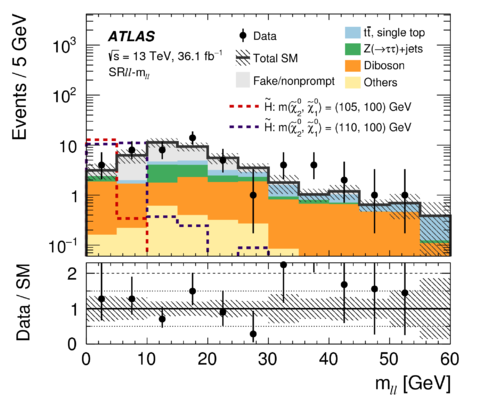 |
|
Figure 08c: Kinematic distributions after the background-only fit showing the data as well as the expected background in the inclusive electroweakino SRℓℓ-mℓℓ [1, 60] (top) and slepton SRℓℓ-mT2100 [100, ∞] (bottom) signal regions. The arrow in the ETmiss/HTlep variables indicates the minimum value of the requirement imposed in the final SR selection. The mℓℓ and mT2 distributions (right) have all the SR requirements applied. Background processes containing fewer than two prompt leptons are categorized as `Fake/nonprompt'. The category `Others' contains rare backgrounds from triboson, Higgs boson, and the remaining top-quark production processes listed in Table 1. The uncertainty bands plotted include all statistical and systematic uncertainties. The last bin includes overflow. The dashed lines represent benchmark signal samples corresponding to the Higgsino H̃ and slepton ℓ̃ simplified models. Orange arrows in the Data/SM panel indicate values that are beyond the y-axis range. png (134kB) pdf (22kB) |
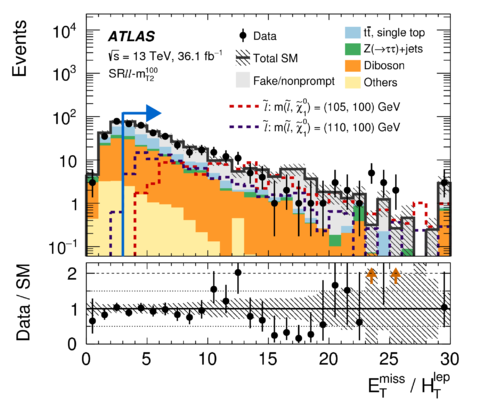 |
|
Figure 08d: Kinematic distributions after the background-only fit showing the data as well as the expected background in the inclusive electroweakino SRℓℓ-mℓℓ [1, 60] (top) and slepton SRℓℓ-mT2100 [100, ∞] (bottom) signal regions. The arrow in the ETmiss/HTlep variables indicates the minimum value of the requirement imposed in the final SR selection. The mℓℓ and mT2 distributions (right) have all the SR requirements applied. Background processes containing fewer than two prompt leptons are categorized as `Fake/nonprompt'. The category `Others' contains rare backgrounds from triboson, Higgs boson, and the remaining top-quark production processes listed in Table 1. The uncertainty bands plotted include all statistical and systematic uncertainties. The last bin includes overflow. The dashed lines represent benchmark signal samples corresponding to the Higgsino H̃ and slepton ℓ̃ simplified models. Orange arrows in the Data/SM panel indicate values that are beyond the y-axis range. png (111kB) pdf (19kB) |
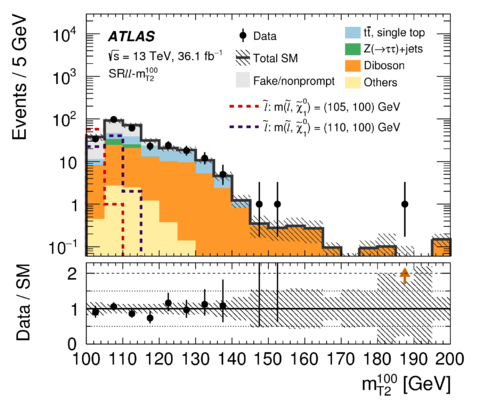 |
|
Figure 09: Comparison of observed and expected event yields after the exclusion fit with the signal strength parameter set to zero in the exclusive signal regions. Background processes containing fewer than two prompt leptons are categorized as `Fake/nonprompt'. The category `Others' contains rare backgrounds from triboson, Higgs boson, and the remaining top-quark production processes listed in Table 1. Uncertainties in the background estimates include both the statistical and systematic uncertainties, where σtot denotes the total uncertainty. png (32kB) pdf (23kB) |
 |
|
Figure 10a: Expected 95% CL exclusion sensitivity (blue dashed line) with pm1σexp (yellow band) from experimental systematic uncertainties and observed limits (red solid line) with pm1σtheory (dotted red line) from signal cross-section uncertainties for simplified models of direct Higgsino (top) and wino (bottom) production. A fit of signals to the mℓℓ spectrum is used to derive the limit, which is projected into the Δ m(χ̃20, χ̃10) vs. m(χ̃20) plane. For Higgsino production, the chargino χ̃1pm mass is assumed to be halfway between the two lightest neutralino masses, while m(χ̃20) = m(χ̃1pm) is assumed for the wino--bino model. The gray regions denote the lower chargino mass limit from LEP. The blue region in the lower plot indicates the limit from the 2ℓ+3ℓ combination of ATLAS Run 1. png (54kB) pdf (256kB) |
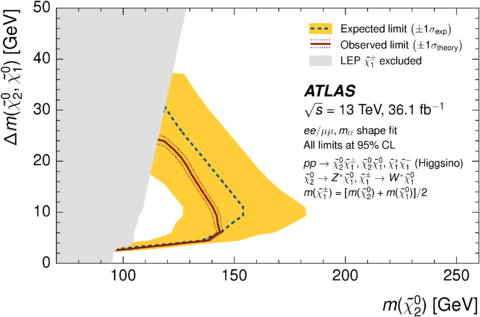 |
|
Figure 10b: Expected 95% CL exclusion sensitivity (blue dashed line) with pm1σexp (yellow band) from experimental systematic uncertainties and observed limits (red solid line) with pm1σtheory (dotted red line) from signal cross-section uncertainties for simplified models of direct Higgsino (top) and wino (bottom) production. A fit of signals to the mℓℓ spectrum is used to derive the limit, which is projected into the Δ m(χ̃20, χ̃10) vs. m(χ̃20) plane. For Higgsino production, the chargino χ̃1pm mass is assumed to be halfway between the two lightest neutralino masses, while m(χ̃20) = m(χ̃1pm) is assumed for the wino--bino model. The gray regions denote the lower chargino mass limit from LEP. The blue region in the lower plot indicates the limit from the 2ℓ+3ℓ combination of ATLAS Run 1. png (57kB) pdf (261kB) |
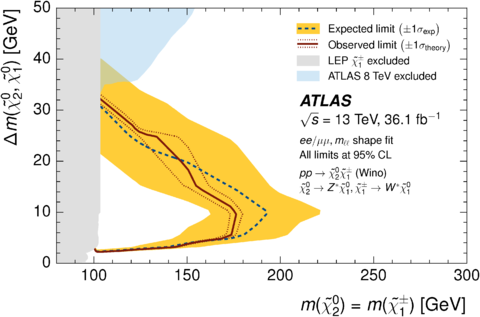 |
|
Figure 11: Expected 95% CL exclusion sensitivity (blue dashed line) with ± 1 σexp (yellow band) from experimental systematic uncertainties and observed limits (red solid line) with ± 1 σtheory (dotted red line) from signal cross-section uncertainties for simplified models of direct slepton production. A fit of slepton signals to the mT2100 spectrum is used to derive the limit, which is projected into the Δ m(ℓ̃, χ̃10) vs. m(ℓ̃) plane. Slepton ℓ̃ refers to the scalar partners of left- and right-handed electrons and muons, which are assumed to be fourfold mass degenerate m(ẽL) = m(ẽR) = m(μ̃L) = m(μ̃R). The gray region is the ẽR limit from LEP, while the blue region is the fourfold mass degenerate slepton limit from ATLAS Run 1. png (51kB) pdf (261kB) |
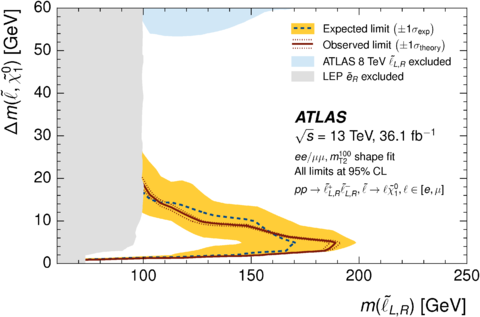 |
|
Figure 12: Observed and expected 95% CL cross-section upper limits as a function of the universal gaugino mass m1/2 for the NUHM2 model. The green and yellow bands around the expected limit indicate the ± 1σ and ± 2σ uncertainties, respectively. The expected signal production cross-sections as well as the associated uncertainty are indicated with the blue solid and dashed lines. The lower x-axis indicates the difference between the χ̃20 and χ̃10 masses for different values of m1/2. A fit of signals to the mℓℓ spectrum is used to derive this limit. png (142kB) eps (27kB) pdf (16kB) |
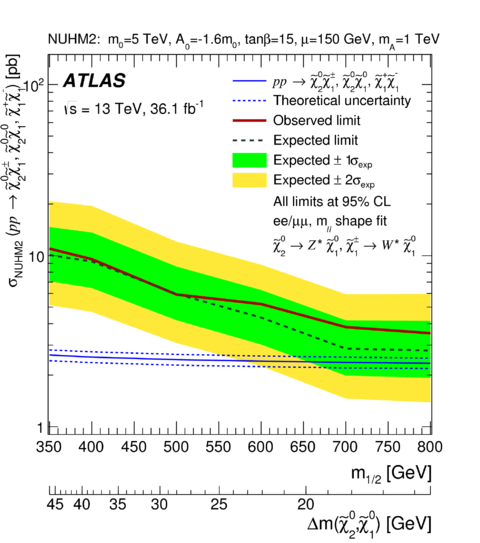 |
| Tables | |
|
Table 01: Simulated samples of Standard Model background processes. The PDF set refers to that used for the matrix element. png (37kB) pdf (60kB) |
 |
|
Table 02: Summary of event selection criteria. The binning scheme used to define the final signal regions is shown in Table 3. Signal leptons and signal jets are used when applying all requirements. png (33kB) pdf (90kB) |
 |
|
Table 03: Signal region binning for the electroweakino and slepton SRs. Each SR is defined by the lepton flavor (ee, μμ, or ℓℓ for both) and a range of mℓℓ (for electroweakino SRs) or mT2100 (for slepton SRs) in GeV. The inclusive bins are used to set model-independent limits, while the exclusive bins are used to derive exclusion limits on signal models. png (80kB) pdf (45kB) |
 |
|
Table 04: Definition of control and validation regions. The common selection criteria in Table 2 are implied unless otherwise specified. png (19kB) pdf (81kB) |
 |
|
Table 05: Left to right: The first two columns present observed (Nobs) and expected (Nexp) event yields in the inclusive signal regions. The latter are obtained by the background-only fit of the control regions, and the errors include both statistical and systematic uncertainties. The next two columns show the observed 95% CL upper limits on the visible cross-section (⟨εσ⟩obs95) and on the number of signal events (Sobs95). The fifth column (Sexp95) shows what the 95% CL upper limit on the number of signal events would be, given an observed number of events equal to the expected number (and pm1σ deviations from the expectation) of background events. The last column indicates the discovery p-value (p(s = 0)), which is capped at 0.5. png (54kB) pdf (66kB) |
 |
|
Table 06: Observed event yields and exclusion fit results with the signal strength parameter set to zero for the exclusive electroweakino and slepton signal regions. Background processes containing fewer than two prompt leptons are categorized as `Fake/nonprompt'. The category `Others' contains rare backgrounds from triboson, Higgs boson, and the remaining top-quark production processes listed in Table 1. Uncertainties in the fitted background estimates combine statistical and systematic uncertainties. png (85kB) pdf (58kB) |
 |
| Auxiliary figures and tables | |
|
Figure
01a: Truth acceptances for the Higgsino χ̃20χ̃1± production process in the inclusive SRℓℓ-mℓℓ regions. Numbers overlaid on the mass planes are the acceptance × 104. png (127kB) pdf (36kB) |
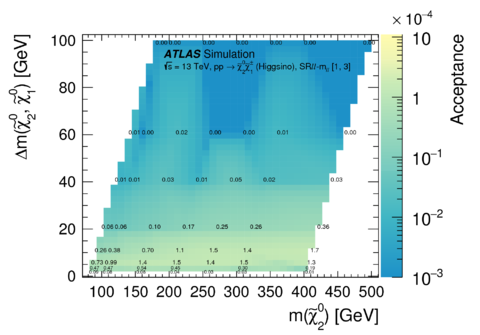 |
|
Figure
01b: Truth acceptances for the Higgsino χ̃20χ̃1± production process in the inclusive SRℓℓ-mℓℓ regions. Numbers overlaid on the mass planes are the acceptance × 104. png (129kB) pdf (37kB) |
 |
|
Figure
01c: Truth acceptances for the Higgsino χ̃20χ̃1± production process in the inclusive SRℓℓ-mℓℓ regions. Numbers overlaid on the mass planes are the acceptance × 104. png (130kB) pdf (37kB) |
 |
|
Figure
01d: Truth acceptances for the Higgsino χ̃20χ̃1± production process in the inclusive SRℓℓ-mℓℓ regions. Numbers overlaid on the mass planes are the acceptance × 104. png (127kB) pdf (37kB) |
 |
|
Figure
01e: Truth acceptances for the Higgsino χ̃20χ̃1± production process in the inclusive SRℓℓ-mℓℓ regions. Numbers overlaid on the mass planes are the acceptance × 104. png (130kB) pdf (37kB) |
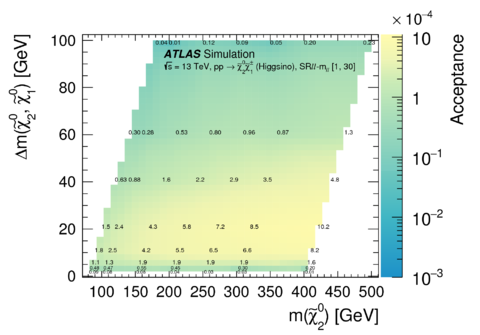 |
|
Figure
01f: Truth acceptances for the Higgsino χ̃20χ̃1± production process in the inclusive SRℓℓ-mℓℓ regions. Numbers overlaid on the mass planes are the acceptance × 104. png (128kB) pdf (36kB) |
 |
|
Figure
01g: Truth acceptances for the Higgsino χ̃20χ̃1± production process in the inclusive SRℓℓ-mℓℓ regions. Numbers overlaid on the mass planes are the acceptance × 104. png (128kB) pdf (36kB) |
 |
|
Figure
02a: Truth acceptances for the Higgsino χ̃20χ̃1+ production process in the inclusive SRℓℓ-mℓℓ regions. Numbers overlaid on the mass planes are the acceptance × 104. png (120kB) pdf (36kB) |
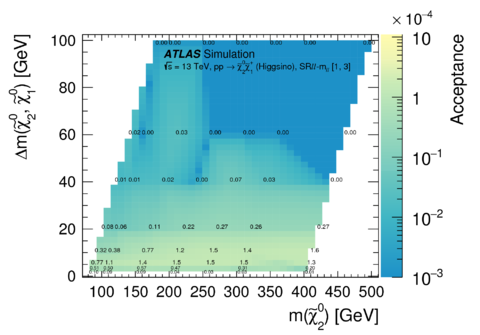 |
|
Figure
02b: Truth acceptances for the Higgsino χ̃20χ̃1+ production process in the inclusive SRℓℓ-mℓℓ regions. Numbers overlaid on the mass planes are the acceptance × 104. png (126kB) pdf (36kB) |
 |
|
Figure
02c: Truth acceptances for the Higgsino χ̃20χ̃1+ production process in the inclusive SRℓℓ-mℓℓ regions. Numbers overlaid on the mass planes are the acceptance × 104. png (129kB) pdf (37kB) |
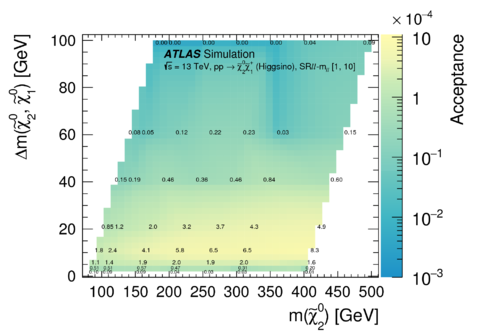 |
|
Figure
02d: Truth acceptances for the Higgsino χ̃20χ̃1+ production process in the inclusive SRℓℓ-mℓℓ regions. Numbers overlaid on the mass planes are the acceptance × 104. png (127kB) pdf (37kB) |
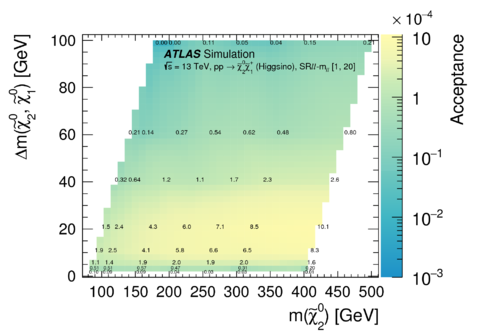 |
|
Figure
02e: Truth acceptances for the Higgsino χ̃20χ̃1+ production process in the inclusive SRℓℓ-mℓℓ regions. Numbers overlaid on the mass planes are the acceptance × 104. png (127kB) pdf (36kB) |
 |
|
Figure
02f: Truth acceptances for the Higgsino χ̃20χ̃1+ production process in the inclusive SRℓℓ-mℓℓ regions. Numbers overlaid on the mass planes are the acceptance × 104. png (128kB) pdf (36kB) |
 |
|
Figure
02g: Truth acceptances for the Higgsino χ̃20χ̃1+ production process in the inclusive SRℓℓ-mℓℓ regions. Numbers overlaid on the mass planes are the acceptance × 104. png (128kB) pdf (36kB) |
 |
|
Figure
03a: Truth acceptances for the Higgsino χ̃20χ̃10 production process in the inclusive SRℓℓ-mℓℓ regions. Numbers overlaid on the mass planes are the acceptance × 104. png (124kB) pdf (36kB) |
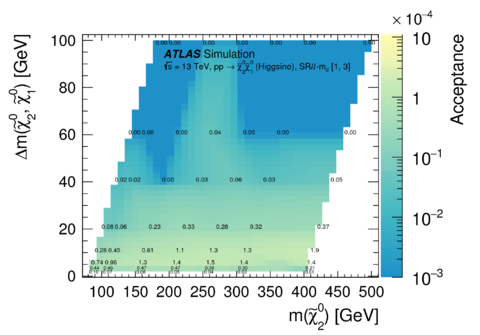 |
|
Figure
03b: Truth acceptances for the Higgsino χ̃20χ̃10 production process in the inclusive SRℓℓ-mℓℓ regions. Numbers overlaid on the mass planes are the acceptance × 104. png (128kB) pdf (37kB) |
 |
|
Figure
03c: Truth acceptances for the Higgsino χ̃20χ̃10 production process in the inclusive SRℓℓ-mℓℓ regions. Numbers overlaid on the mass planes are the acceptance × 104. png (126kB) pdf (37kB) |
 |
|
Figure
03d: Truth acceptances for the Higgsino χ̃20χ̃10 production process in the inclusive SRℓℓ-mℓℓ regions. Numbers overlaid on the mass planes are the acceptance × 104. png (128kB) pdf (36kB) |
 |
|
Figure
03e: Truth acceptances for the Higgsino χ̃20χ̃10 production process in the inclusive SRℓℓ-mℓℓ regions. Numbers overlaid on the mass planes are the acceptance × 104. png (126kB) pdf (36kB) |
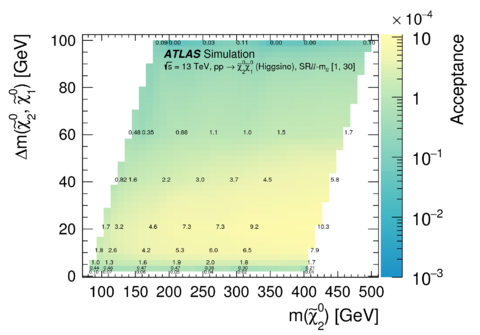 |
|
Figure
03f: Truth acceptances for the Higgsino χ̃20χ̃10 production process in the inclusive SRℓℓ-mℓℓ regions. Numbers overlaid on the mass planes are the acceptance × 104. png (125kB) pdf (36kB) |
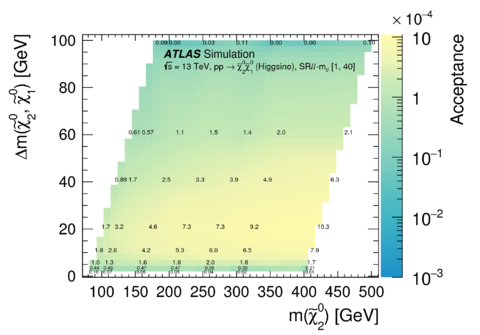 |
|
Figure
03g: Truth acceptances for the Higgsino χ̃20χ̃10 production process in the inclusive SRℓℓ-mℓℓ regions. Numbers overlaid on the mass planes are the acceptance × 104. png (127kB) pdf (36kB) |
 |
|
Figure
04a: Truth acceptances for the Higgsino χ̃1+χ̃1- production process in the inclusive SRℓℓ-mℓℓ regions. Numbers overlaid on the mass planes are the acceptance × 104. png (130kB) pdf (36kB) |
 |
|
Figure
04b: Truth acceptances for the Higgsino χ̃1+χ̃1- production process in the inclusive SRℓℓ-mℓℓ regions. Numbers overlaid on the mass planes are the acceptance × 104. png (133kB) pdf (36kB) |
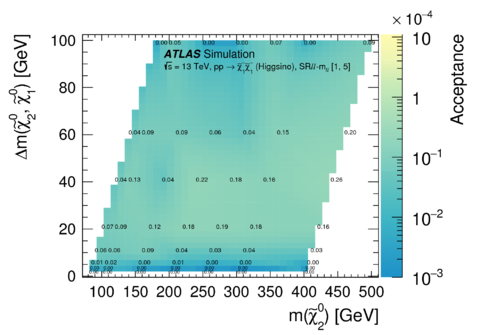 |
|
Figure
04c: Truth acceptances for the Higgsino χ̃1+χ̃1- production process in the inclusive SRℓℓ-mℓℓ regions. Numbers overlaid on the mass planes are the acceptance × 104. png (132kB) pdf (35kB) |
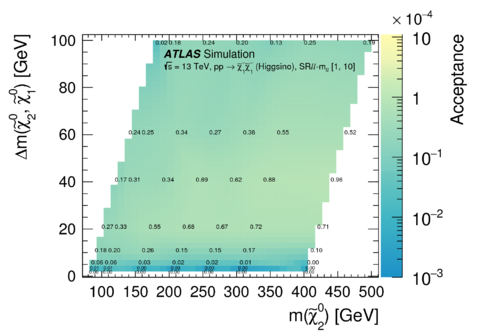 |
|
Figure
04d: Truth acceptances for the Higgsino χ̃1+χ̃1- production process in the inclusive SRℓℓ-mℓℓ regions. Numbers overlaid on the mass planes are the acceptance × 104. png (124kB) pdf (35kB) |
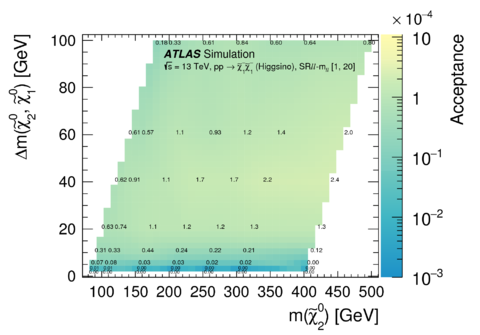 |
|
Figure
04e: Truth acceptances for the Higgsino χ̃1+χ̃1- production process in the inclusive SRℓℓ-mℓℓ regions. Numbers overlaid on the mass planes are the acceptance × 104. png (125kB) pdf (35kB) |
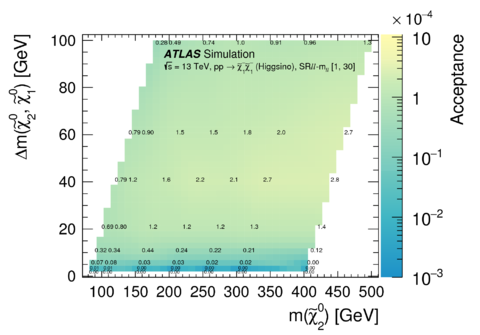 |
|
Figure
04f: Truth acceptances for the Higgsino χ̃1+χ̃1- production process in the inclusive SRℓℓ-mℓℓ regions. Numbers overlaid on the mass planes are the acceptance × 104. png (124kB) pdf (35kB) |
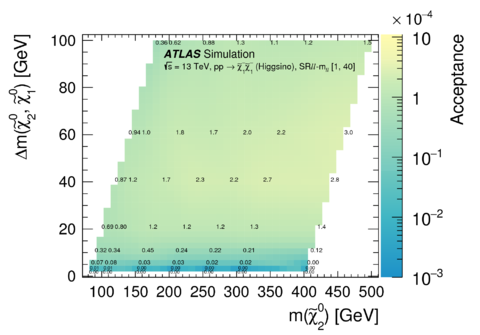 |
|
Figure
04g: Truth acceptances for the Higgsino χ̃1+χ̃1- production process in the inclusive SRℓℓ-mℓℓ regions. Numbers overlaid on the mass planes are the acceptance × 104. png (124kB) pdf (35kB) |
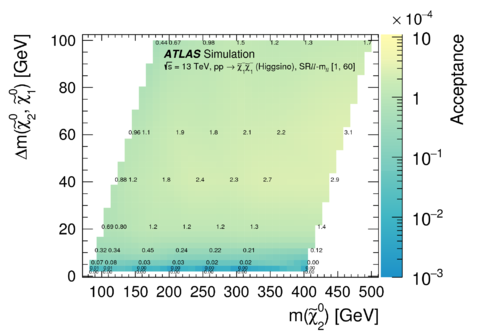 |
|
Figure
05a: Truth acceptances for the ℓ̃ℓ̃ production in the inclusive SRℓℓ-mT2100 regions. Numbers overlaid on the mass planes are the acceptance × 103. png (142kB) pdf (23kB) |
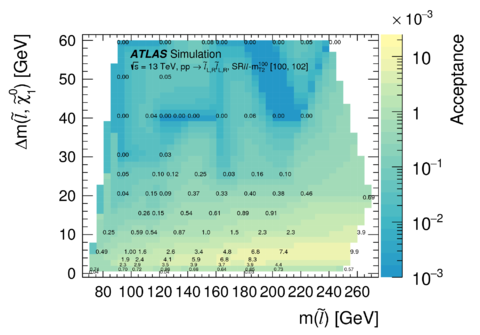 |
|
Figure
05b: Truth acceptances for the ℓ̃ℓ̃ production in the inclusive SRℓℓ-mT2100 regions. Numbers overlaid on the mass planes are the acceptance × 103. png (153kB) pdf (39kB) |
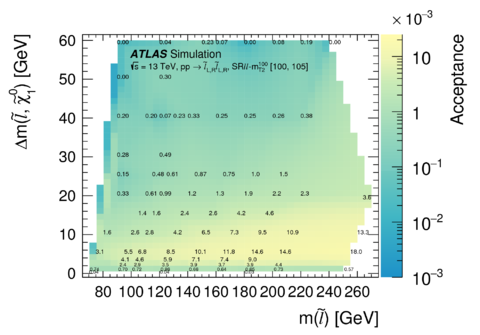 |
|
Figure
05c: Truth acceptances for the ℓ̃ℓ̃ production in the inclusive SRℓℓ-mT2100 regions. Numbers overlaid on the mass planes are the acceptance × 103. png (147kB) pdf (38kB) |
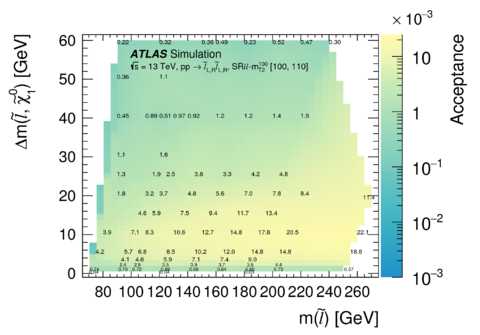 |
|
Figure
05d: Truth acceptances for the ℓ̃ℓ̃ production in the inclusive SRℓℓ-mT2100 regions. Numbers overlaid on the mass planes are the acceptance × 103. png (149kB) pdf (38kB) |
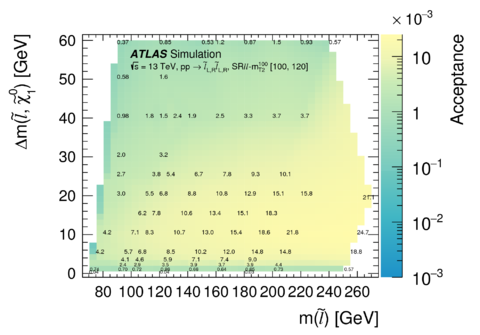 |
|
Figure
05e: Truth acceptances for the ℓ̃ℓ̃ production in the inclusive SRℓℓ-mT2100 regions. Numbers overlaid on the mass planes are the acceptance × 103. png (145kB) pdf (38kB) |
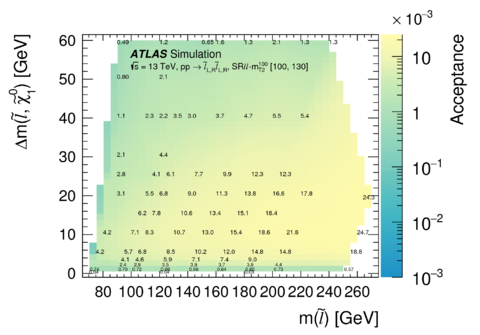 |
|
Figure
05f: Truth acceptances for the ℓ̃ℓ̃ production in the inclusive SRℓℓ-mT2100 regions. Numbers overlaid on the mass planes are the acceptance × 103. png (145kB) pdf (38kB) |
 |
|
Figure
06a: Efficiencies for the Higgsino χ̃20χ̃1+ production process in the inclusive SRℓℓ-mℓℓ regions. Efficiencies are computed as the ``acceptance times efficiency" divided by the acceptance. The black line indicates the maximum allowed value of Δ m or mT2 for the inclusive signal region under study. png (120kB) pdf (33kB) |
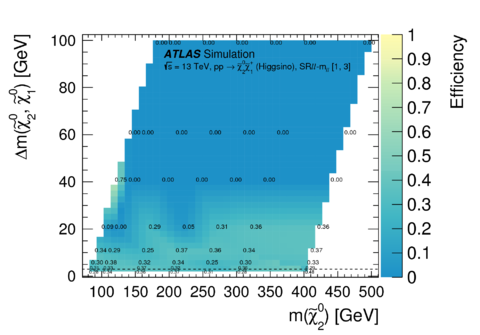 |
|
Figure
06b: Efficiencies for the Higgsino χ̃20χ̃1+ production process in the inclusive SRℓℓ-mℓℓ regions. Efficiencies are computed as the ``acceptance times efficiency" divided by the acceptance. The black line indicates the maximum allowed value of Δ m or mT2 for the inclusive signal region under study. png (125kB) pdf (33kB) |
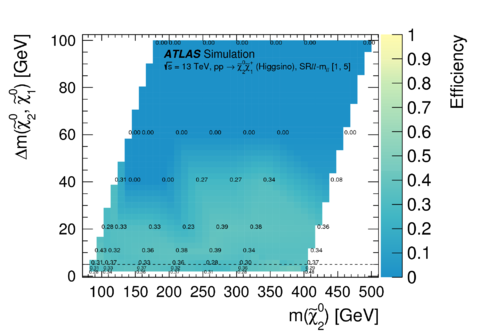 |
|
Figure
06c: Efficiencies for the Higgsino χ̃20χ̃1+ production process in the inclusive SRℓℓ-mℓℓ regions. Efficiencies are computed as the ``acceptance times efficiency" divided by the acceptance. The black line indicates the maximum allowed value of Δ m or mT2 for the inclusive signal region under study. png (139kB) pdf (37kB) |
 |
|
Figure
06d: Efficiencies for the Higgsino χ̃20χ̃1+ production process in the inclusive SRℓℓ-mℓℓ regions. Efficiencies are computed as the ``acceptance times efficiency" divided by the acceptance. The black line indicates the maximum allowed value of Δ m or mT2 for the inclusive signal region under study. png (145kB) pdf (35kB) |
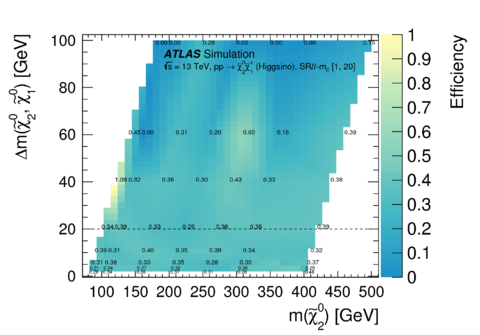 |
|
Figure
06e: Efficiencies for the Higgsino χ̃20χ̃1+ production process in the inclusive SRℓℓ-mℓℓ regions. Efficiencies are computed as the ``acceptance times efficiency" divided by the acceptance. The black line indicates the maximum allowed value of Δ m or mT2 for the inclusive signal region under study. png (146kB) pdf (35kB) |
 |
|
Figure
06f: Efficiencies for the Higgsino χ̃20χ̃1+ production process in the inclusive SRℓℓ-mℓℓ regions. Efficiencies are computed as the ``acceptance times efficiency" divided by the acceptance. The black line indicates the maximum allowed value of Δ m or mT2 for the inclusive signal region under study. png (146kB) pdf (36kB) |
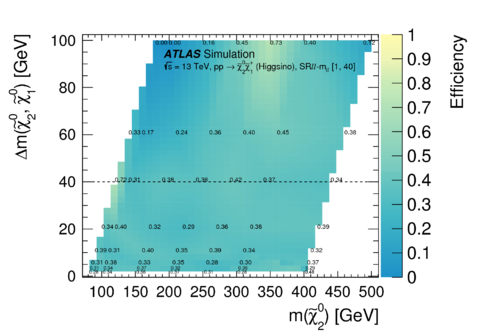 |
|
Figure
06g: Efficiencies for the Higgsino χ̃20χ̃1+ production process in the inclusive SRℓℓ-mℓℓ regions. Efficiencies are computed as the ``acceptance times efficiency" divided by the acceptance. The black line indicates the maximum allowed value of Δ m or mT2 for the inclusive signal region under study. png (146kB) pdf (36kB) |
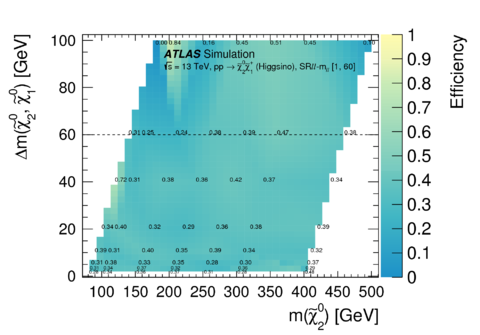 |
|
Figure
07a: Efficiencies for the Higgsino χ̃20χ̃1- production process in the inclusive SRℓℓ-mℓℓ regions. Efficiencies are computed as the ``acceptance times efficiency" divided by the acceptance. The black line indicates the maximum allowed value of Δ m or mT2 for the inclusive signal region under study. png (120kB) pdf (33kB) |
 |
|
Figure
07b: Efficiencies for the Higgsino χ̃20χ̃1- production process in the inclusive SRℓℓ-mℓℓ regions. Efficiencies are computed as the ``acceptance times efficiency" divided by the acceptance. The black line indicates the maximum allowed value of Δ m or mT2 for the inclusive signal region under study. png (126kB) pdf (34kB) |
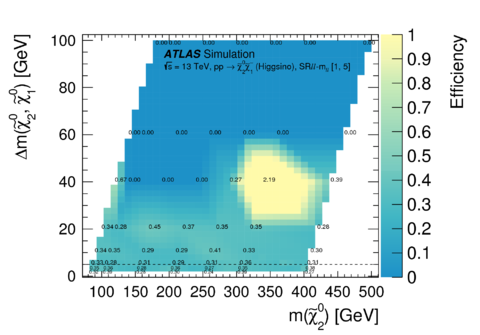 |
|
Figure
07c: Efficiencies for the Higgsino χ̃20χ̃1- production process in the inclusive SRℓℓ-mℓℓ regions. Efficiencies are computed as the ``acceptance times efficiency" divided by the acceptance. The black line indicates the maximum allowed value of Δ m or mT2 for the inclusive signal region under study. png (138kB) pdf (36kB) |
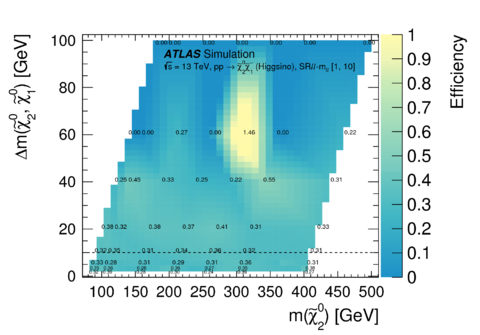 |
|
Figure
07d: Efficiencies for the Higgsino χ̃20χ̃1- production process in the inclusive SRℓℓ-mℓℓ regions. Efficiencies are computed as the ``acceptance times efficiency" divided by the acceptance. The black line indicates the maximum allowed value of Δ m or mT2 for the inclusive signal region under study. png (140kB) pdf (36kB) |
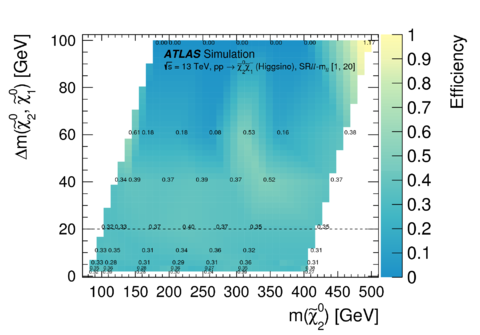 |
|
Figure
07e: Efficiencies for the Higgsino χ̃20χ̃1- production process in the inclusive SRℓℓ-mℓℓ regions. Efficiencies are computed as the ``acceptance times efficiency" divided by the acceptance. The black line indicates the maximum allowed value of Δ m or mT2 for the inclusive signal region under study. png (145kB) pdf (36kB) |
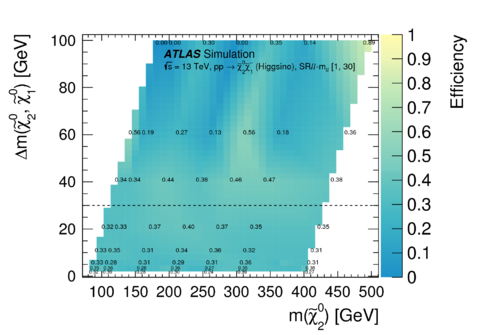 |
|
Figure
07f: Efficiencies for the Higgsino χ̃20χ̃1- production process in the inclusive SRℓℓ-mℓℓ regions. Efficiencies are computed as the ``acceptance times efficiency" divided by the acceptance. The black line indicates the maximum allowed value of Δ m or mT2 for the inclusive signal region under study. png (143kB) pdf (36kB) |
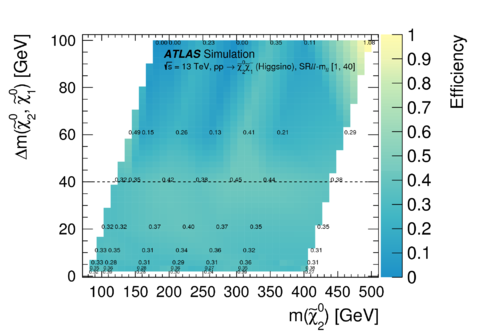 |
|
Figure
07g: Efficiencies for the Higgsino χ̃20χ̃1- production process in the inclusive SRℓℓ-mℓℓ regions. Efficiencies are computed as the ``acceptance times efficiency" divided by the acceptance. The black line indicates the maximum allowed value of Δ m or mT2 for the inclusive signal region under study. png (144kB) pdf (35kB) |
 |
|
Figure
08a: Efficiencies for the Higgsino χ̃20χ̃10 production process in the inclusive SRℓℓ-mℓℓ regions. Efficiencies are computed as the ``acceptance times efficiency" divided by the acceptance. The black line indicates the maximum allowed value of Δ m or mT2 for the inclusive signal region under study. png (121kB) pdf (34kB) |
 |
|
Figure
08b: Efficiencies for the Higgsino χ̃20χ̃10 production process in the inclusive SRℓℓ-mℓℓ regions. Efficiencies are computed as the ``acceptance times efficiency" divided by the acceptance. The black line indicates the maximum allowed value of Δ m or mT2 for the inclusive signal region under study. png (128kB) pdf (35kB) |
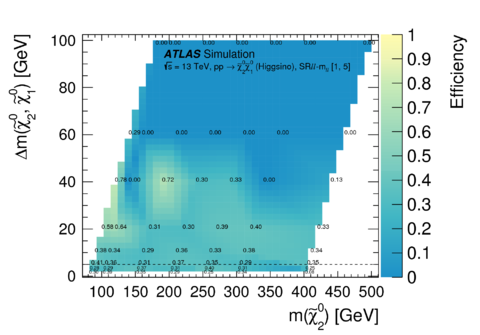 |
|
Figure
08c: Efficiencies for the Higgsino χ̃20χ̃10 production process in the inclusive SRℓℓ-mℓℓ regions. Efficiencies are computed as the ``acceptance times efficiency" divided by the acceptance. The black line indicates the maximum allowed value of Δ m or mT2 for the inclusive signal region under study. png (138kB) pdf (36kB) |
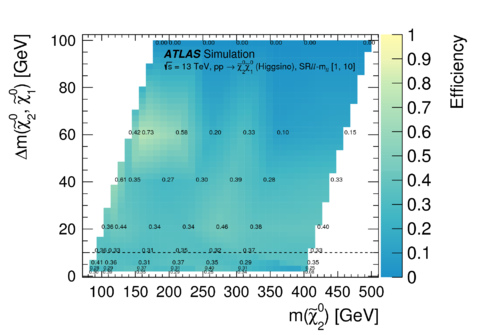 |
|
Figure
08d: Efficiencies for the Higgsino χ̃20χ̃10 production process in the inclusive SRℓℓ-mℓℓ regions. Efficiencies are computed as the ``acceptance times efficiency" divided by the acceptance. The black line indicates the maximum allowed value of Δ m or mT2 for the inclusive signal region under study. png (139kB) pdf (35kB) |
 |
|
Figure
08e: Efficiencies for the Higgsino χ̃20χ̃10 production process in the inclusive SRℓℓ-mℓℓ regions. Efficiencies are computed as the ``acceptance times efficiency" divided by the acceptance. The black line indicates the maximum allowed value of Δ m or mT2 for the inclusive signal region under study. png (138kB) pdf (35kB) |
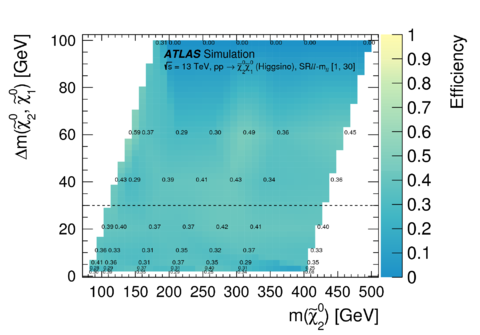 |
|
Figure
08f: Efficiencies for the Higgsino χ̃20χ̃10 production process in the inclusive SRℓℓ-mℓℓ regions. Efficiencies are computed as the ``acceptance times efficiency" divided by the acceptance. The black line indicates the maximum allowed value of Δ m or mT2 for the inclusive signal region under study. png (138kB) pdf (35kB) |
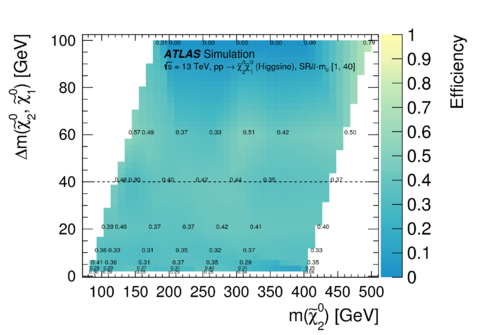 |
|
Figure
08g: Efficiencies for the Higgsino χ̃20χ̃10 production process in the inclusive SRℓℓ-mℓℓ regions. Efficiencies are computed as the ``acceptance times efficiency" divided by the acceptance. The black line indicates the maximum allowed value of Δ m or mT2 for the inclusive signal region under study. png (141kB) pdf (35kB) |
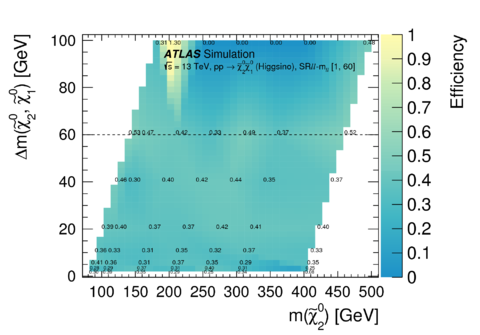 |
|
Figure
09a: Efficiencies for the Higgsino χ̃1+χ̃1- production process in the inclusive SRℓℓ-mℓℓ regions. Efficiencies are computed as the ``acceptance times efficiency" divided by the acceptance. The black line indicates the maximum allowed value of Δ m or mT2 for the inclusive signal region under study. png (128kB) pdf (36kB) |
 |
|
Figure
09b: Efficiencies for the Higgsino χ̃1+χ̃1- production process in the inclusive SRℓℓ-mℓℓ regions. Efficiencies are computed as the ``acceptance times efficiency" divided by the acceptance. The black line indicates the maximum allowed value of Δ m or mT2 for the inclusive signal region under study. png (142kB) pdf (38kB) |
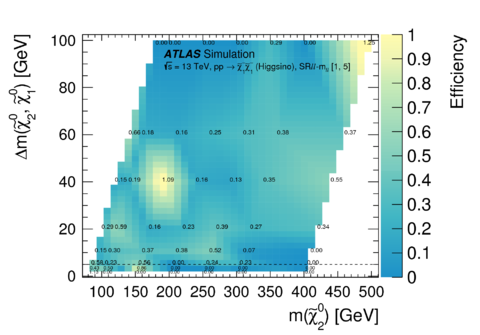 |
|
Figure
09c: Efficiencies for the Higgsino χ̃1+χ̃1- production process in the inclusive SRℓℓ-mℓℓ regions. Efficiencies are computed as the ``acceptance times efficiency" divided by the acceptance. The black line indicates the maximum allowed value of Δ m or mT2 for the inclusive signal region under study. png (141kB) pdf (36kB) |
 |
|
Figure
09d: Efficiencies for the Higgsino χ̃1+χ̃1- production process in the inclusive SRℓℓ-mℓℓ regions. Efficiencies are computed as the ``acceptance times efficiency" divided by the acceptance. The black line indicates the maximum allowed value of Δ m or mT2 for the inclusive signal region under study. png (141kB) pdf (35kB) |
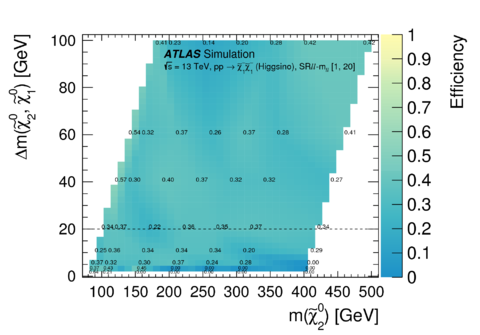 |
|
Figure
09e: Efficiencies for the Higgsino χ̃1+χ̃1- production process in the inclusive SRℓℓ-mℓℓ regions. Efficiencies are computed as the ``acceptance times efficiency" divided by the acceptance. The black line indicates the maximum allowed value of Δ m or mT2 for the inclusive signal region under study. png (142kB) pdf (35kB) |
 |
|
Figure
09f: Efficiencies for the Higgsino χ̃1+χ̃1- production process in the inclusive SRℓℓ-mℓℓ regions. Efficiencies are computed as the ``acceptance times efficiency" divided by the acceptance. The black line indicates the maximum allowed value of Δ m or mT2 for the inclusive signal region under study. png (141kB) pdf (35kB) |
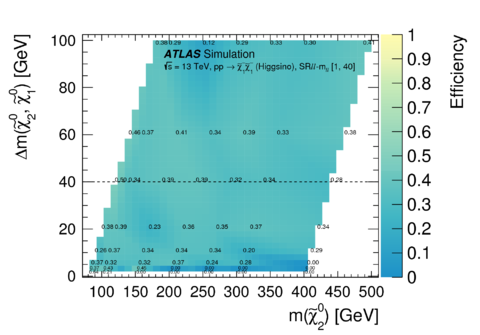 |
|
Figure
09g: Efficiencies for the Higgsino χ̃1+χ̃1- production process in the inclusive SRℓℓ-mℓℓ regions. Efficiencies are computed as the ``acceptance times efficiency" divided by the acceptance. The black line indicates the maximum allowed value of Δ m or mT2 for the inclusive signal region under study. png (142kB) pdf (35kB) |
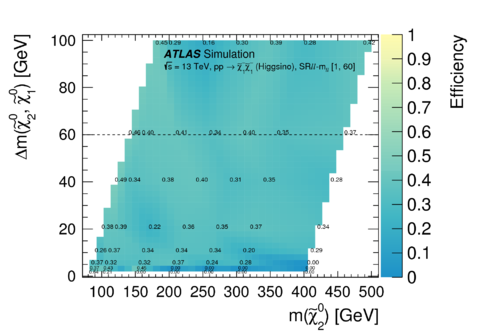 |
|
Figure
10a: Efficiencies for the ℓ̃ℓ̃ production in the inclusive SRℓℓ-mT2100 regions. Efficiencies are computed as the ``acceptance times efficiency" divided by the acceptance. The black line indicates the maximum allowed value of Δ m or mT2 for the inclusive signal region under study. png (145kB) pdf (23kB) |
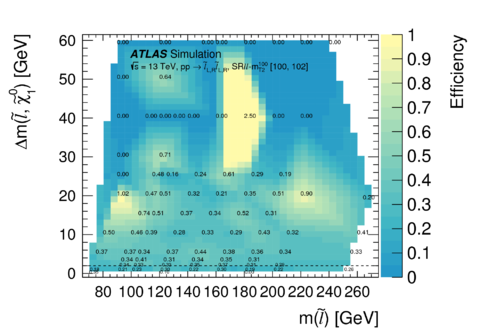 |
|
Figure
10b: Efficiencies for the ℓ̃ℓ̃ production in the inclusive SRℓℓ-mT2100 regions. Efficiencies are computed as the ``acceptance times efficiency" divided by the acceptance. The black line indicates the maximum allowed value of Δ m or mT2 for the inclusive signal region under study. png (172kB) pdf (40kB) |
 |
|
Figure
10c: Efficiencies for the ℓ̃ℓ̃ production in the inclusive SRℓℓ-mT2100 regions. Efficiencies are computed as the ``acceptance times efficiency" divided by the acceptance. The black line indicates the maximum allowed value of Δ m or mT2 for the inclusive signal region under study. png (170kB) pdf (38kB) |
 |
|
Figure
10d: Efficiencies for the ℓ̃ℓ̃ production in the inclusive SRℓℓ-mT2100 regions. Efficiencies are computed as the ``acceptance times efficiency" divided by the acceptance. The black line indicates the maximum allowed value of Δ m or mT2 for the inclusive signal region under study. png (169kB) pdf (37kB) |
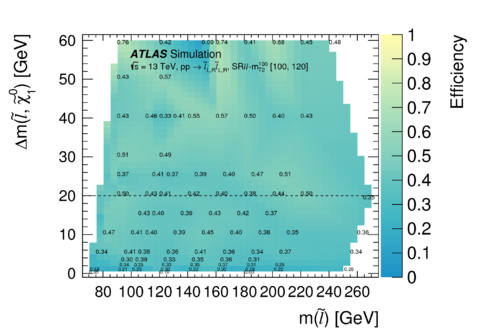 |
|
Figure
10e: Efficiencies for the ℓ̃ℓ̃ production in the inclusive SRℓℓ-mT2100 regions. Efficiencies are computed as the ``acceptance times efficiency" divided by the acceptance. The black line indicates the maximum allowed value of Δ m or mT2 for the inclusive signal region under study. png (167kB) pdf (37kB) |
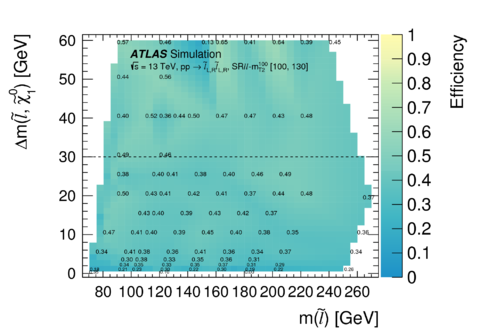 |
|
Figure
10f: Efficiencies for the ℓ̃ℓ̃ production in the inclusive SRℓℓ-mT2100 regions. Efficiencies are computed as the ``acceptance times efficiency" divided by the acceptance. The black line indicates the maximum allowed value of Δ m or mT2 for the inclusive signal region under study. png (164kB) pdf (37kB) |
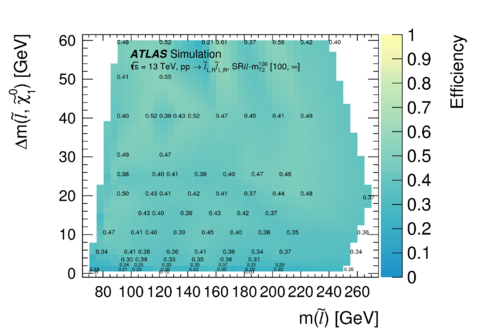 |
|
Figure
11: Signal lepton efficiencies for electrons and muons, averaged over all Higgsino and slepton samples. Efficiencies are shown for leptons within detector acceptance, and with lepton pT within a factor of 3 of Δ m(ℓ,χ̃10) for slepton samples, or within a factor of 3 of Δ m(χ̃20,χ̃10)/2 for Higgsino samples. Uncertainty bands represent the range of efficiencies observed across all signal samples for the given pT bin. The η-dependence is consistent with values reported in ATLAS combined performance papers. png (32kB) pdf (15kB) |
 |
|
Figure
12a: Cross-sections of the Higgsino signal grid for each production process denoted in the caption. png (126kB) pdf (21kB) |
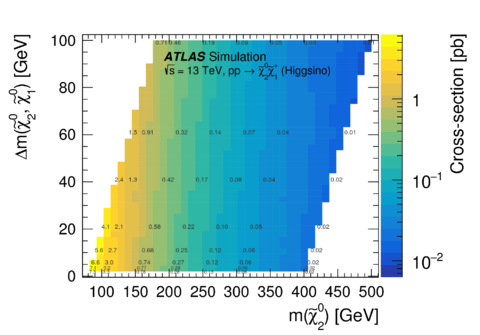 |
|
Figure
12b: Cross-sections of the Higgsino signal grid for each production process denoted in the caption. png (128kB) pdf (21kB) |
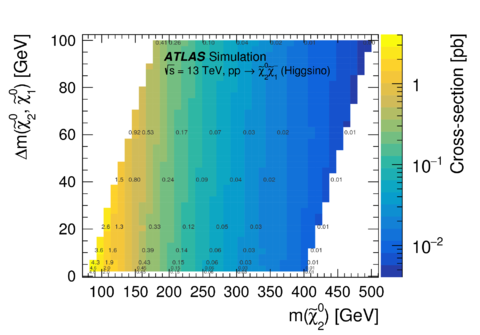 |
|
Figure
12c: Cross-sections of the Higgsino signal grid for each production process denoted in the caption. png (127kB) pdf (21kB) |
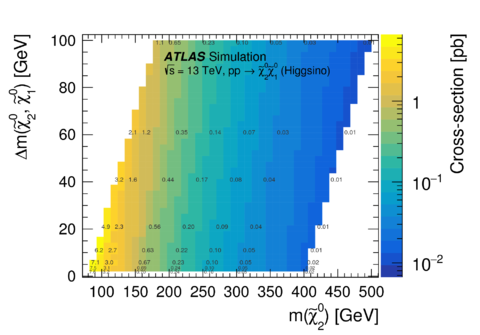 |
|
Figure
12d: Cross-sections of the Higgsino signal grid for each production process denoted in the caption. png (126kB) pdf (21kB) |
 |
|
Figure
13a: Cross-sections of the wino--bino signal grid for each production process in the caption. png (158kB) pdf (22kB) |
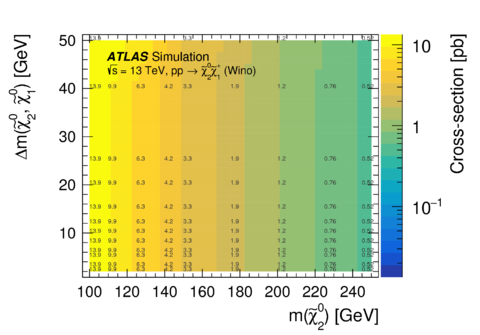 |
|
Figure
13b: Cross-sections of the wino--bino signal grid for each production process in the caption. png (150kB) pdf (22kB) |
 |
|
Figure
14: Total cross-sections of the slepton simplified model signal grid. Slepton refers to a the scalar partners of the left- and right-handed electrons and muons, which are assumed to be mass degenerate m(ẽL) = m(ẽR) = m(μ̃L) = m(μ̃R). png (145kB) pdf (22kB) |
 |
|
Figure
15a: Distributions after the background-only fit of the control regions. The category `Others' contains rare backgrounds from triboson, Higgs boson, and the remaining top-quark production processes listed in Table 1. The last bin includes overflow. The blue arrow indicates the final requirement used to define the selection. png (81kB) pdf (16kB) |
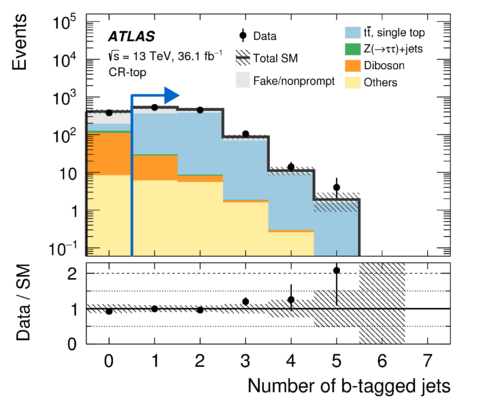 |
|
Figure
15b: Distributions after the background-only fit of the control regions. The category `Others' contains rare backgrounds from triboson, Higgs boson, and the remaining top-quark production processes listed in Table 1. The last bin includes overflow. The blue arrow indicates the final requirement used to define the selection. png (50kB) pdf (17kB) |
 |
|
Figure
15c: Distributions after the background-only fit of the control regions. The category `Others' contains rare backgrounds from triboson, Higgs boson, and the remaining top-quark production processes listed in Table 1. The last bin includes overflow. The blue arrow indicates the final requirement used to define the selection. png (44kB) pdf (18kB) |
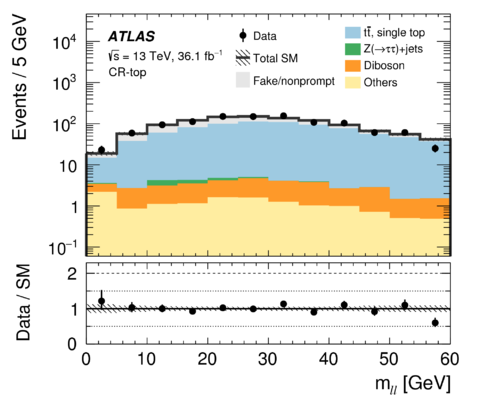 |
|
Figure
15d: Distributions after the background-only fit of the control regions. The category `Others' contains rare backgrounds from triboson, Higgs boson, and the remaining top-quark production processes listed in Table 1. The last bin includes overflow. The blue arrow indicates the final requirement used to define the selection. png (52kB) pdf (18kB) |
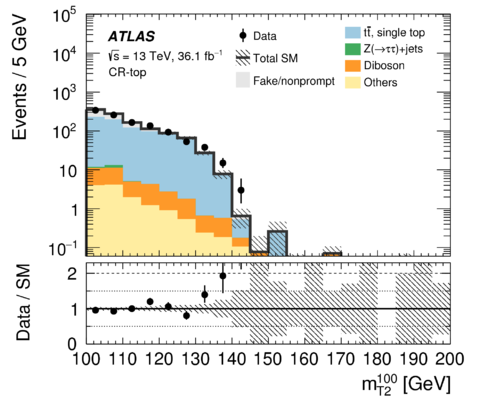 |
|
Figure
15e: Distributions after the background-only fit of the control regions. The category `Others' contains rare backgrounds from triboson, Higgs boson, and the remaining top-quark production processes listed in Table 1. The last bin includes overflow. The blue arrow indicates the final requirement used to define the selection. png (51kB) pdf (17kB) |
 |
|
Figure
15f: Distributions after the background-only fit of the control regions. The category `Others' contains rare backgrounds from triboson, Higgs boson, and the remaining top-quark production processes listed in Table 1. The last bin includes overflow. The blue arrow indicates the final requirement used to define the selection. png (50kB) pdf (17kB) |
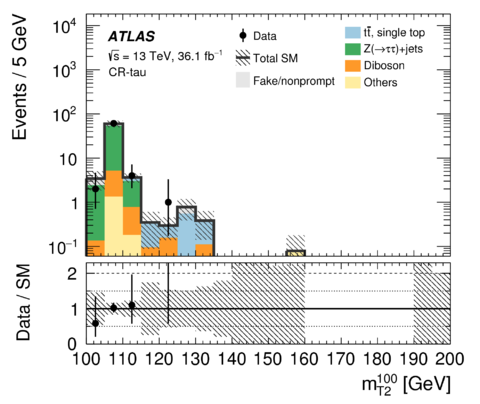 |
|
Figure
16a: Distributions after the background-only fit in validation regions. The category `Others' contains rare backgrounds from triboson, Higgs boson, and the remaining top-quark production processes listed in Table 1. The last bin includes overflow. The blue arrow in the ETmiss / HTlep distributions indicates the minimum value of the final requirement used to define the selection. Orange arrows in the Data/SM panel indicate values that are beyond the y-axis range. png (85kB) pdf (18kB) |
 |
|
Figure
16b: Distributions after the background-only fit in validation regions. The category `Others' contains rare backgrounds from triboson, Higgs boson, and the remaining top-quark production processes listed in Table 1. The last bin includes overflow. The blue arrow in the ETmiss / HTlep distributions indicates the minimum value of the final requirement used to define the selection. Orange arrows in the Data/SM panel indicate values that are beyond the y-axis range. png (49kB) pdf (17kB) |
 |
|
Figure
16c: Distributions after the background-only fit in validation regions. The category `Others' contains rare backgrounds from triboson, Higgs boson, and the remaining top-quark production processes listed in Table 1. The last bin includes overflow. The blue arrow in the ETmiss / HTlep distributions indicates the minimum value of the final requirement used to define the selection. Orange arrows in the Data/SM panel indicate values that are beyond the y-axis range. png (84kB) pdf (17kB) |
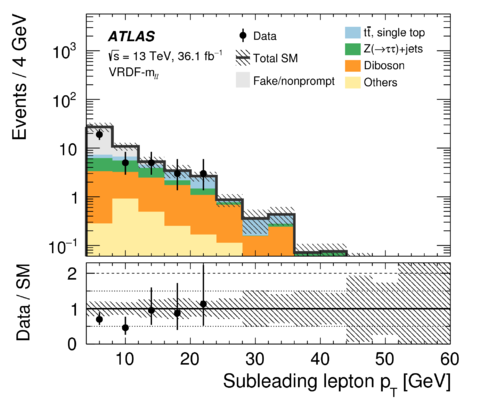 |
|
Figure
16d: Distributions after the background-only fit in validation regions. The category `Others' contains rare backgrounds from triboson, Higgs boson, and the remaining top-quark production processes listed in Table 1. The last bin includes overflow. The blue arrow in the ETmiss / HTlep distributions indicates the minimum value of the final requirement used to define the selection. Orange arrows in the Data/SM panel indicate values that are beyond the y-axis range. png (52kB) pdf (18kB) |
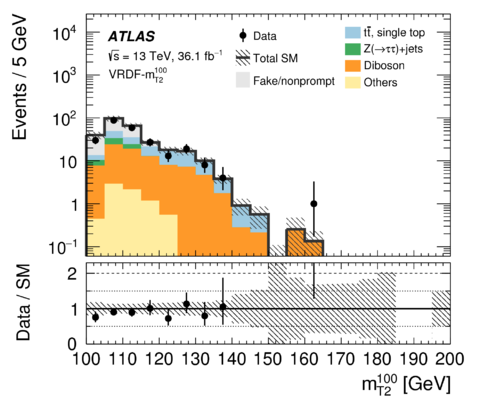 |
|
Figure
16e: Distributions after the background-only fit in validation regions. The category `Others' contains rare backgrounds from triboson, Higgs boson, and the remaining top-quark production processes listed in Table 1. The last bin includes overflow. The blue arrow in the ETmiss / HTlep distributions indicates the minimum value of the final requirement used to define the selection. Orange arrows in the Data/SM panel indicate values that are beyond the y-axis range. png (101kB) pdf (19kB) |
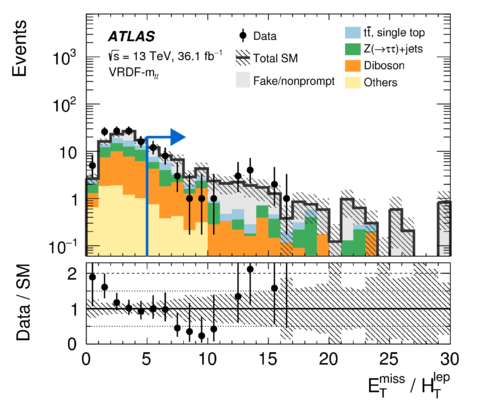 |
|
Figure
16f: Distributions after the background-only fit in validation regions. The category `Others' contains rare backgrounds from triboson, Higgs boson, and the remaining top-quark production processes listed in Table 1. The last bin includes overflow. The blue arrow in the ETmiss / HTlep distributions indicates the minimum value of the final requirement used to define the selection. Orange arrows in the Data/SM panel indicate values that are beyond the y-axis range. png (109kB) pdf (21kB) |
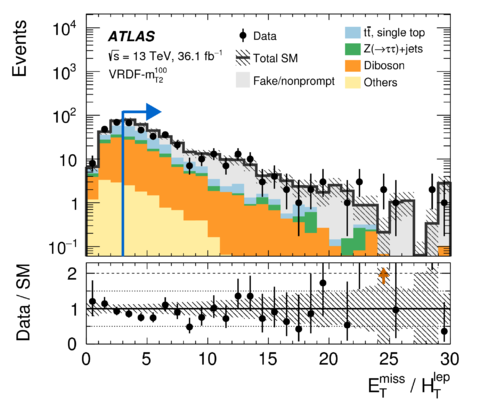 |
|
Figure
17a: Distributions after the background-only fit for the same-sign validation regions, where the subleading lepton is either the electron ee+μ e or muon μμ + eμ. The category `Others' contains rare backgrounds from triboson, Higgs boson, and the remaining top-quark production processes listed in Table 1. The last bin includes overflow. Orange arrows in the Data/SM panel indicate values that are beyond the y-axis range. png (50kB) pdf (17kB) |
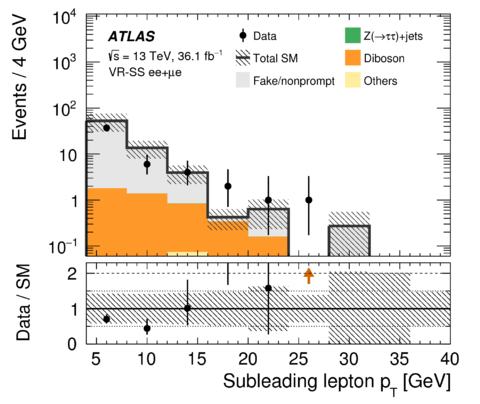 |
|
Figure
17b: Distributions after the background-only fit for the same-sign validation regions, where the subleading lepton is either the electron ee+μ e or muon μμ + eμ. The category `Others' contains rare backgrounds from triboson, Higgs boson, and the remaining top-quark production processes listed in Table 1. The last bin includes overflow. Orange arrows in the Data/SM panel indicate values that are beyond the y-axis range. png (47kB) pdf (17kB) |
 |
|
Figure
17c: Distributions after the background-only fit for the same-sign validation regions, where the subleading lepton is either the electron ee+μ e or muon μμ + eμ. The category `Others' contains rare backgrounds from triboson, Higgs boson, and the remaining top-quark production processes listed in Table 1. The last bin includes overflow. Orange arrows in the Data/SM panel indicate values that are beyond the y-axis range. png (50kB) pdf (17kB) |
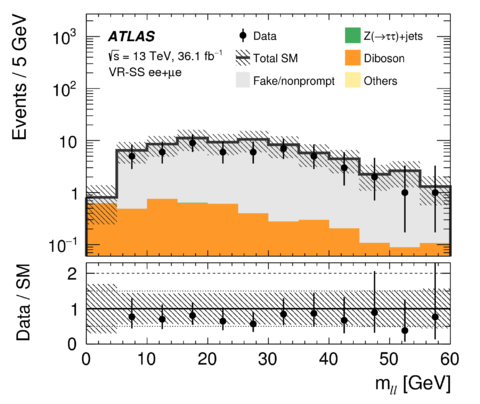 |
|
Figure
17d: Distributions after the background-only fit for the same-sign validation regions, where the subleading lepton is either the electron ee+μ e or muon μμ + eμ. The category `Others' contains rare backgrounds from triboson, Higgs boson, and the remaining top-quark production processes listed in Table 1. The last bin includes overflow. Orange arrows in the Data/SM panel indicate values that are beyond the y-axis range. png (47kB) pdf (18kB) |
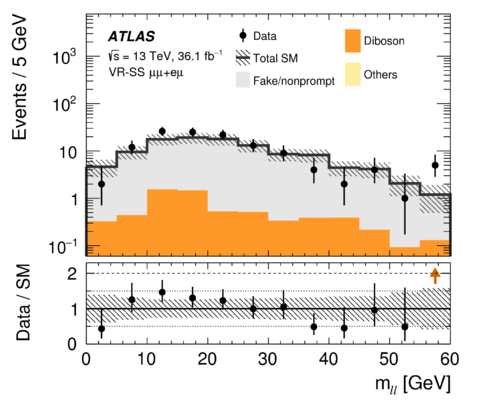 |
|
Figure
17e: Distributions after the background-only fit for the same-sign validation regions, where the subleading lepton is either the electron ee+μ e or muon μμ + eμ. The category `Others' contains rare backgrounds from triboson, Higgs boson, and the remaining top-quark production processes listed in Table 1. The last bin includes overflow. Orange arrows in the Data/SM panel indicate values that are beyond the y-axis range. png (46kB) pdf (17kB) |
 |
|
Figure
17f: Distributions after the background-only fit for the same-sign validation regions, where the subleading lepton is either the electron ee+μ e or muon μμ + eμ. The category `Others' contains rare backgrounds from triboson, Higgs boson, and the remaining top-quark production processes listed in Table 1. The last bin includes overflow. Orange arrows in the Data/SM panel indicate values that are beyond the y-axis range. png (50kB) pdf (17kB) |
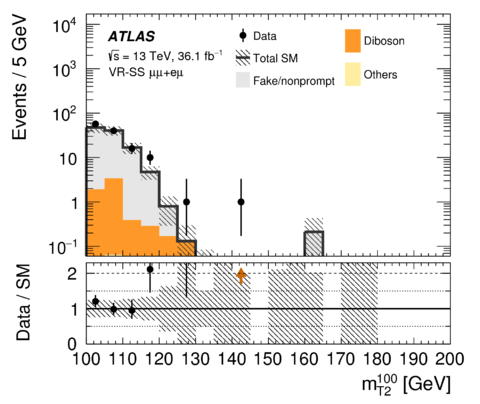 |
|
Figure
18: Distributions after the background-only fit for the same-sign validation region. The category `Others' contains rare backgrounds from triboson, Higgs boson, and the remaining top-quark production processes listed in Table 1. The last bin includes overflow. Orange arrows in the Data/SM panel indicate values that are beyond the y-axis range. png (52kB) pdf (18kB) |
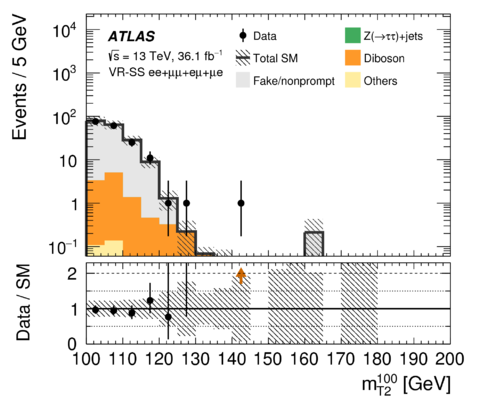 |
|
Figure
19a: Distributions after the exclusion fit to the SRℓℓ-mℓℓ signal regions with the signal strength parameter set to zero. The category `Others' contains rare backgrounds from triboson, Higgs boson, and the remaining top-quark production processes listed in Table 1. The last bin includes overflow. The blue arrow in the ETmiss / HTlep distribution indicates the minimum value of the final requirement used to define the selection. Benchmark Higgsino H̃ signals are overlaid as dashed lines. png (113kB) pdf (18kB) |
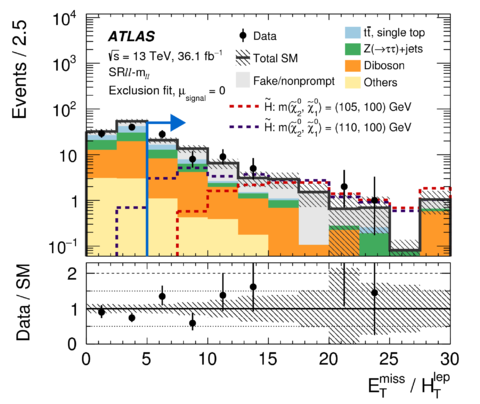 |
|
Figure
19b: Distributions after the exclusion fit to the SRℓℓ-mℓℓ signal regions with the signal strength parameter set to zero. The category `Others' contains rare backgrounds from triboson, Higgs boson, and the remaining top-quark production processes listed in Table 1. The last bin includes overflow. The blue arrow in the ETmiss / HTlep distribution indicates the minimum value of the final requirement used to define the selection. Benchmark Higgsino H̃ signals are overlaid as dashed lines. png (110kB) pdf (18kB) |
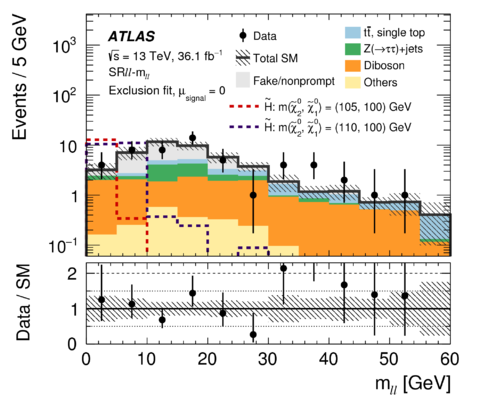 |
|
Figure
20a: Distributions after the exclusion fit to the SRℓℓ-mT2100 signal regions with the signal strength parameter set to zero. The category `Others' contains rare backgrounds from triboson, Higgs boson, and the remaining top-quark production processes listed in Table 1. The last bin includes overflow. The blue arrow in the ETmiss / HTlep distribution indicates the minimum value of the final requirement used to define the selection. Benchmark slepton ℓ̃ signals are overlaid as dashed lines. Orange arrows in the Data/SM panel indicate values that are beyond the y-axis range. png (135kB) pdf (22kB) |
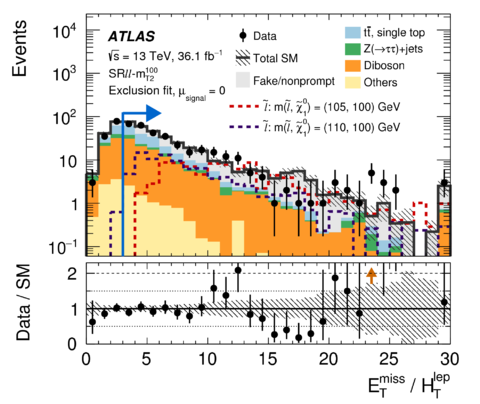 |
|
Figure
20b: Distributions after the exclusion fit to the SRℓℓ-mT2100 signal regions with the signal strength parameter set to zero. The category `Others' contains rare backgrounds from triboson, Higgs boson, and the remaining top-quark production processes listed in Table 1. The last bin includes overflow. The blue arrow in the ETmiss / HTlep distribution indicates the minimum value of the final requirement used to define the selection. Benchmark slepton ℓ̃ signals are overlaid as dashed lines. Orange arrows in the Data/SM panel indicate values that are beyond the y-axis range. png (115kB) pdf (19kB) |
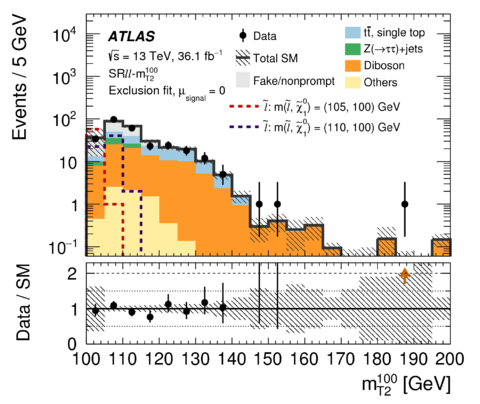 |
|
Figure
21a: Distributions after the background-only fit of kinematic variables used to define selections common to all signal regions, i.e. not including requirements specific to the electroweakino or slepton SR definitions. Blue arrows in the upper panel denote the final requirement used to define the common SR, otherwise all selections are applied. The category `Others' contains rare backgrounds from triboson, Higgs boson, and the remaining top-quark production processes listed in Table 1. The first (last) bin includes underflow (overflow). Benchmark Higgsino H̃ and slepton ℓ̃ signals are overlaid as dashed lines. Orange arrows in the Data/SM panel indicate values that are beyond the y-axis range. png (110kB) pdf (19kB) |
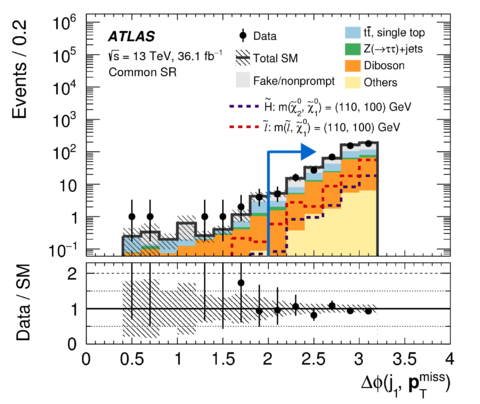 |
|
Figure
21b: Distributions after the background-only fit of kinematic variables used to define selections common to all signal regions, i.e. not including requirements specific to the electroweakino or slepton SR definitions. Blue arrows in the upper panel denote the final requirement used to define the common SR, otherwise all selections are applied. The category `Others' contains rare backgrounds from triboson, Higgs boson, and the remaining top-quark production processes listed in Table 1. The first (last) bin includes underflow (overflow). Benchmark Higgsino H̃ and slepton ℓ̃ signals are overlaid as dashed lines. Orange arrows in the Data/SM panel indicate values that are beyond the y-axis range. png (111kB) pdf (20kB) |
 |
|
Figure
21c: Distributions after the background-only fit of kinematic variables used to define selections common to all signal regions, i.e. not including requirements specific to the electroweakino or slepton SR definitions. Blue arrows in the upper panel denote the final requirement used to define the common SR, otherwise all selections are applied. The category `Others' contains rare backgrounds from triboson, Higgs boson, and the remaining top-quark production processes listed in Table 1. The first (last) bin includes underflow (overflow). Benchmark Higgsino H̃ and slepton ℓ̃ signals are overlaid as dashed lines. Orange arrows in the Data/SM panel indicate values that are beyond the y-axis range. png (122kB) pdf (21kB) |
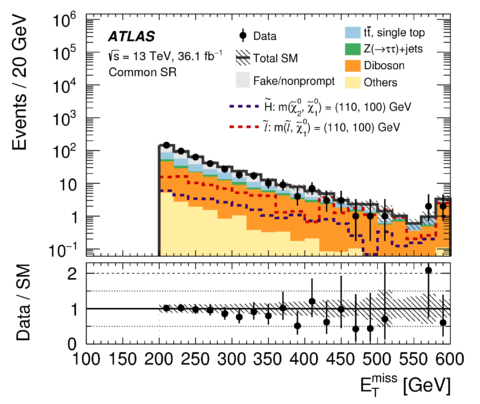 |
|
Figure
21d: Distributions after the background-only fit of kinematic variables used to define selections common to all signal regions, i.e. not including requirements specific to the electroweakino or slepton SR definitions. Blue arrows in the upper panel denote the final requirement used to define the common SR, otherwise all selections are applied. The category `Others' contains rare backgrounds from triboson, Higgs boson, and the remaining top-quark production processes listed in Table 1. The first (last) bin includes underflow (overflow). Benchmark Higgsino H̃ and slepton ℓ̃ signals are overlaid as dashed lines. Orange arrows in the Data/SM panel indicate values that are beyond the y-axis range. png (125kB) pdf (21kB) |
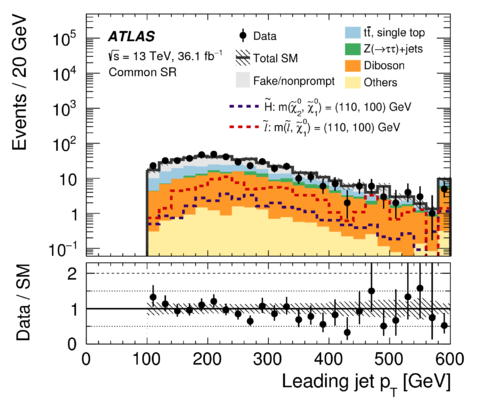 |
|
Figure
21e: Distributions after the background-only fit of kinematic variables used to define selections common to all signal regions, i.e. not including requirements specific to the electroweakino or slepton SR definitions. Blue arrows in the upper panel denote the final requirement used to define the common SR, otherwise all selections are applied. The category `Others' contains rare backgrounds from triboson, Higgs boson, and the remaining top-quark production processes listed in Table 1. The first (last) bin includes underflow (overflow). Benchmark Higgsino H̃ and slepton ℓ̃ signals are overlaid as dashed lines. Orange arrows in the Data/SM panel indicate values that are beyond the y-axis range. png (123kB) pdf (23kB) |
 |
|
Figure
21f: Distributions after the background-only fit of kinematic variables used to define selections common to all signal regions, i.e. not including requirements specific to the electroweakino or slepton SR definitions. Blue arrows in the upper panel denote the final requirement used to define the common SR, otherwise all selections are applied. The category `Others' contains rare backgrounds from triboson, Higgs boson, and the remaining top-quark production processes listed in Table 1. The first (last) bin includes underflow (overflow). Benchmark Higgsino H̃ and slepton ℓ̃ signals are overlaid as dashed lines. Orange arrows in the Data/SM panel indicate values that are beyond the y-axis range. png (112kB) pdf (19kB) |
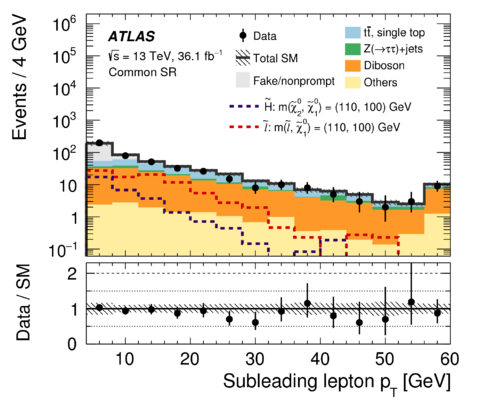 |
|
Figure
21g: Distributions after the background-only fit of kinematic variables used to define selections common to all signal regions, i.e. not including requirements specific to the electroweakino or slepton SR definitions. Blue arrows in the upper panel denote the final requirement used to define the common SR, otherwise all selections are applied. The category `Others' contains rare backgrounds from triboson, Higgs boson, and the remaining top-quark production processes listed in Table 1. The first (last) bin includes underflow (overflow). Benchmark Higgsino H̃ and slepton ℓ̃ signals are overlaid as dashed lines. Orange arrows in the Data/SM panel indicate values that are beyond the y-axis range. png (131kB) pdf (23kB) |
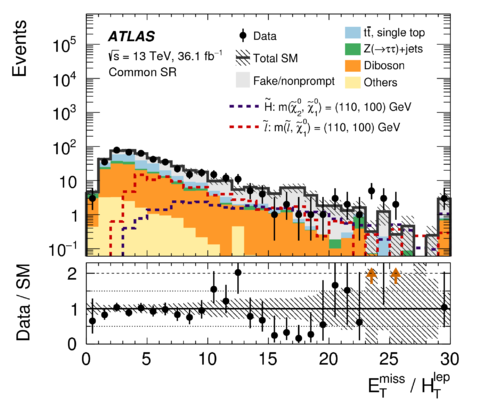 |
|
Figure
21h: Distributions after the background-only fit of kinematic variables used to define selections common to all signal regions, i.e. not including requirements specific to the electroweakino or slepton SR definitions. Blue arrows in the upper panel denote the final requirement used to define the common SR, otherwise all selections are applied. The category `Others' contains rare backgrounds from triboson, Higgs boson, and the remaining top-quark production processes listed in Table 1. The first (last) bin includes underflow (overflow). Benchmark Higgsino H̃ and slepton ℓ̃ signals are overlaid as dashed lines. Orange arrows in the Data/SM panel indicate values that are beyond the y-axis range. png (117kB) pdf (21kB) |
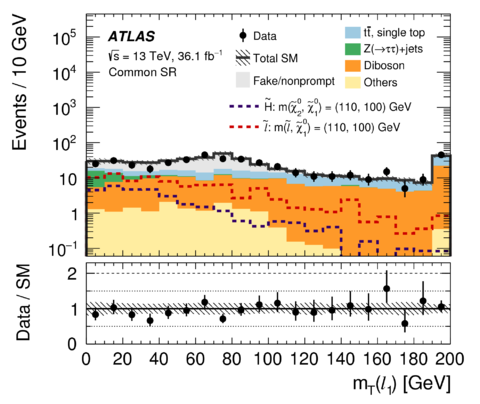 |
|
Figure
21i: Distributions after the background-only fit of kinematic variables used to define selections common to all signal regions, i.e. not including requirements specific to the electroweakino or slepton SR definitions. Blue arrows in the upper panel denote the final requirement used to define the common SR, otherwise all selections are applied. The category `Others' contains rare backgrounds from triboson, Higgs boson, and the remaining top-quark production processes listed in Table 1. The first (last) bin includes underflow (overflow). Benchmark Higgsino H̃ and slepton ℓ̃ signals are overlaid as dashed lines. Orange arrows in the Data/SM panel indicate values that are beyond the y-axis range. png (120kB) pdf (21kB) |
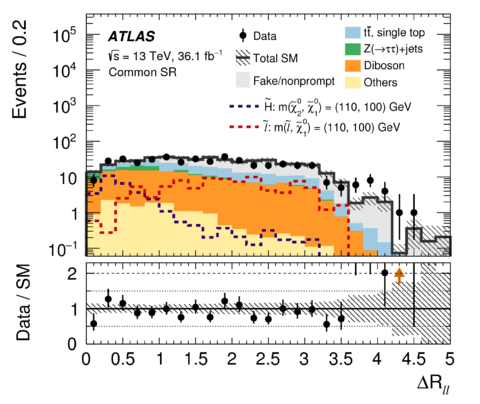 |
|
Figure
21j: Distributions after the background-only fit of kinematic variables used to define selections common to all signal regions, i.e. not including requirements specific to the electroweakino or slepton SR definitions. Blue arrows in the upper panel denote the final requirement used to define the common SR, otherwise all selections are applied. The category `Others' contains rare backgrounds from triboson, Higgs boson, and the remaining top-quark production processes listed in Table 1. The first (last) bin includes underflow (overflow). Benchmark Higgsino H̃ and slepton ℓ̃ signals are overlaid as dashed lines. Orange arrows in the Data/SM panel indicate values that are beyond the y-axis range. png (146kB) pdf (25kB) |
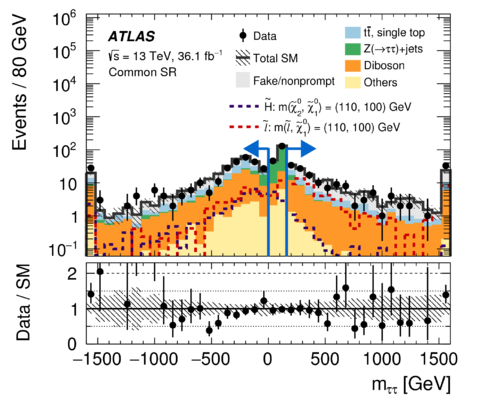 |
|
Figure
21k: Distributions after the background-only fit of kinematic variables used to define selections common to all signal regions, i.e. not including requirements specific to the electroweakino or slepton SR definitions. Blue arrows in the upper panel denote the final requirement used to define the common SR, otherwise all selections are applied. The category `Others' contains rare backgrounds from triboson, Higgs boson, and the remaining top-quark production processes listed in Table 1. The first (last) bin includes underflow (overflow). Benchmark Higgsino H̃ and slepton ℓ̃ signals are overlaid as dashed lines. Orange arrows in the Data/SM panel indicate values that are beyond the y-axis range. png (101kB) pdf (17kB) |
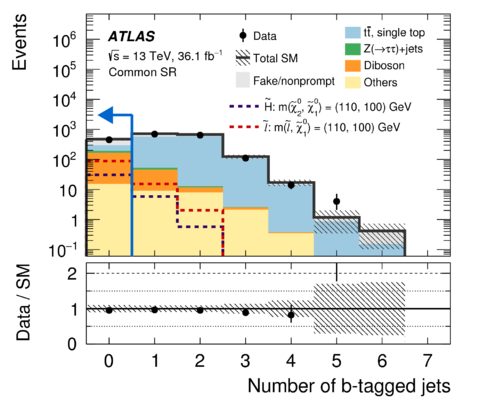 |
|
Figure
22: Comparison of expected and observed event yields in the inclusive signal regions after the background-only fit. Background processes containing fewer than two prompt leptons are categorized as `Fake/nonprompt'. The category `Others' contains rare backgrounds from triboson, Higgs boson, and the remaining top-quark production processes listed in Table 1. Uncertainties in the background estimates include both the statistical and systematic uncertainties, where σtot denotes the total uncertainty. png (23kB) pdf (19kB) |
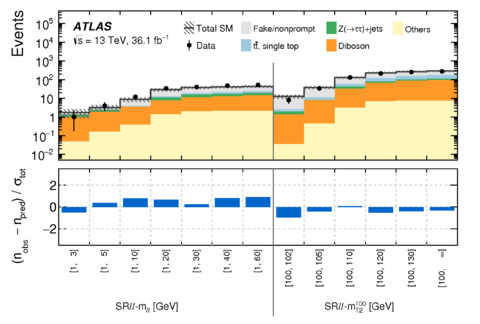 |
|
Figure
23a: Numbers show the CLs values in the Higgsino simplified model. png (57kB) pdf (291kB) |
 |
|
Figure
23b: Numbers show the CLs values in the Higgsino simplified model. png (57kB) pdf (291kB) |
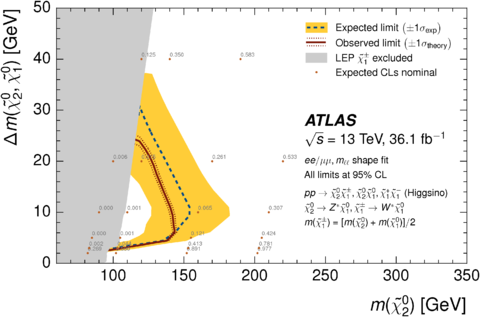 |
|
Figure
24a: Numbers show the CLs values in the wino--bino simplified model. png (65kB) pdf (296kB) |
 |
|
Figure
24b: Numbers show the CLs values in the wino--bino simplified model. png (65kB) pdf (296kB) |
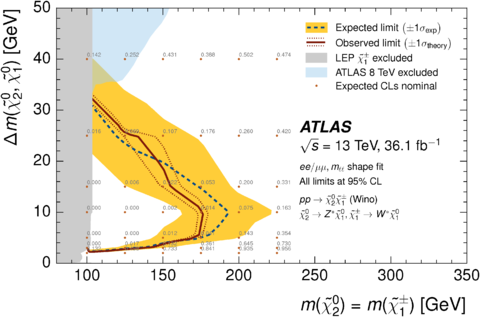 |
|
Figure
25a: Numbers show the CLs values in the slepton simplified model. png (63kB) pdf (262kB) |
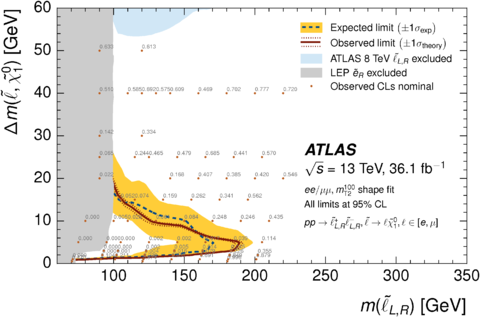 |
|
Figure
25b: Numbers show the CLs values in the slepton simplified model. png (63kB) pdf (262kB) |
 |
|
Figure
26a: Numbers show 95% CL model-dependent upper limits on the inclusive Higgsino signal cross-sections. png (56kB) pdf (292kB) |
 |
|
Figure
26b: Numbers show 95% CL model-dependent upper limits on the inclusive Higgsino signal cross-sections. png (56kB) pdf (292kB) |
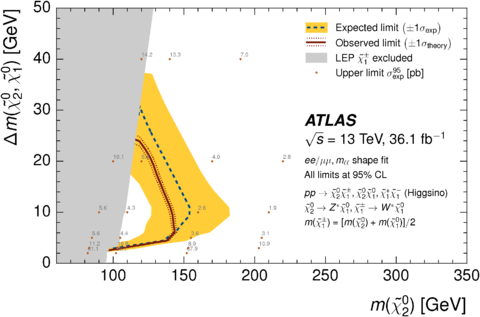 |
|
Figure
27a: Numbers show 95% CL model-dependent upper limits on the inclusive signal cross-sections of the wino--bino model. png (63kB) pdf (297kB) |
 |
|
Figure
27b: Numbers show 95% CL model-dependent upper limits on the inclusive signal cross-sections of the wino--bino model. png (63kB) pdf (297kB) |
 |
|
Figure
28a: Numbers show the 95% CL model-dependent upper limits on the slepton signal cross-sections, assuming a fourfold mass degeneracy m(ẽL,R) = m(μ̃L,R). png (61kB) pdf (296kB) |
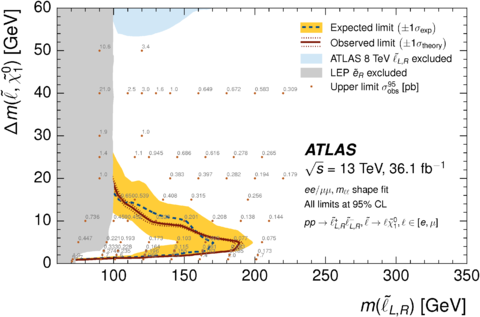 |
|
Figure
28b: Numbers show the 95% CL model-dependent upper limits on the slepton signal cross-sections, assuming a fourfold mass degeneracy m(ẽL,R) = m(μ̃L,R). png (61kB) pdf (296kB) |
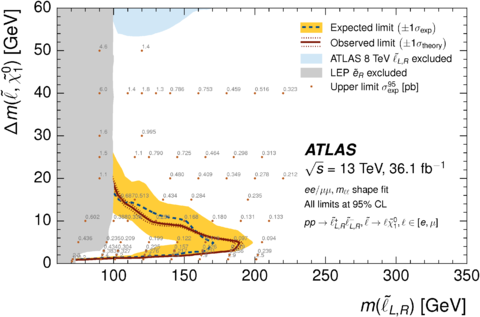 |
|
Figure
29: Expected and observed 95% CL cross-section upper limits as a function of the universal gaugino mass m1/2 for the NUHM2 model. The gray numbers indicate the values of the observed limit. The green and yellow bands around the expected limit indicate the ± 1σ and ± 2σ uncertainties, respectively. The expected signal production cross-sections as well as the associated uncertainty are indicated with the blue solid and dashed lines. The lower x-axis indicates the difference between the χ̃20 and χ̃10 masses for different values of m1/2. A fit of signals to the mℓℓ spectrum is used to derive this limit. png (151kB) eps (28kB) pdf (16kB) |
 |
|
Figure
30a: Model-dependent exclusion limits as presented in the main text, but with a logarithmic scale for the axis labeling the mass splitting. png (52kB) pdf (256kB) |
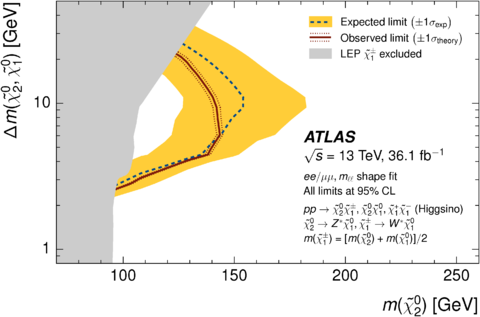 |
|
Figure
30b: Model-dependent exclusion limits as presented in the main text, but with a logarithmic scale for the axis labeling the mass splitting. png (56kB) pdf (261kB) |
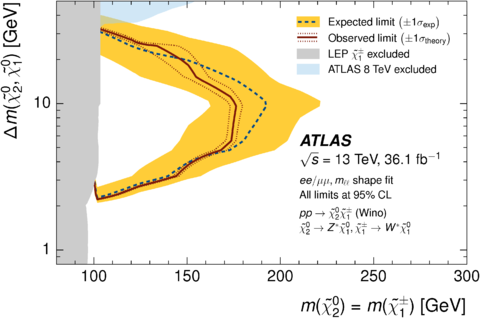 |
|
Figure
30c: Model-dependent exclusion limits as presented in the main text, but with a logarithmic scale for the axis labeling the mass splitting. png (52kB) pdf (260kB) |
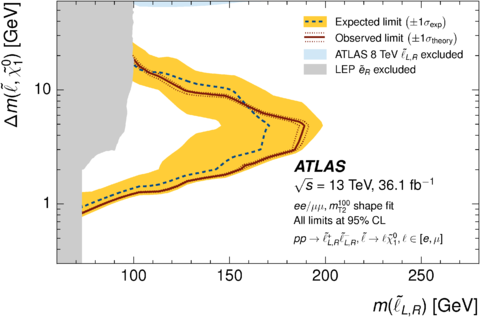 |
|
Figure
31: Higgsino simplified model exclusion limits as presented in the main text, but projected into the m(χ̃1±) - m(χ̃10) vs m(χ̃1±) plane with a logarithmic scale for the axis labeling the mass splitting. png (49kB) pdf (256kB) |
 |
|
Table
01: Observed event yields and exclusion fit results with the signal strength parameter set to zero for the exclusive electroweakino and slepton signal regions. Background processes containing fewer than two prompt leptons are categorized as `Fake/nonprompt'. The category `Others' contains rare backgrounds from triboson, Higgs boson, and the remaining top-quark production processes listed in Table 1. Uncertainties in the fitted background estimates combine statistical and systematic uncertainties. png (87kB) pdf (58kB) |
 |
|
Table
02: Observed event yields and background-only fit results for the inclusive electroweakino and slepton signal regions. Background processes containing fewer than two prompt leptons are categorized as `Fake/nonprompt'. The category `Others' contains rare backgrounds from triboson, Higgs boson, and the remaining top-quark production processes listed in Table 1. Uncertainties in the fitted background estimates combine statistical and systematic uncertainties. png (42kB) pdf (56kB) |
 |
|
Table
03: Nominal observed and expected CLs values for Higgsino signals. png (26kB) pdf (37kB) |
 |
|
Table
04: Nominal observed and expected CLs values for wino--bino signals. png (22kB) pdf (37kB) |
 |
|
Table
05: Nominal observed and expected CLs values for slepton signals. png (35kB) pdf (37kB) |
 |
|
Table
06: Upper limits on observed (expected) Higgsino simplified model signal cross section σobs (exp)95 and signal strength σobs (exp)95 / σtheory. png (38kB) pdf (36kB) |
 |
|
Table
07: Upper limits on observed (expected) wino--bino simplified model signal cross section σobs (exp)95 and signal strength σobs (exp)95 / σtheory. png (40kB) pdf (36kB) |
 |
|
Table
08: Upper limits on observed (expected) slepton simplified model signal cross section σobs (exp)95 and signal strength σobs (exp)95 / σtheory. png (57kB) pdf (37kB) |
 |
|
Table
09: Event counts for Higgsino H̃ and slepton ℓ̃ signals after sequential selections for the inclusive SRℓℓ-mℓℓ and SRℓℓ-mT2100 regions. Weighted events are normalised to mathcalL = 36.1 fb-1 and the inclusive cross section σ, while raw MC events are also shown. The generator filter with efficiency εfilt applied to the Higgsino signal requires truth ETmiss > 50 GeV and at least 2 leptons with pT > 3 GeV, while only the ETmiss > 50 GeV requirement is applied to the slepton signal. The mathcalB refers to the branching ratio Z(*) → ℓ+ℓ- in the Higgsino processes. ``Lepton truth matching" requires that the selected leptons are consistent with being decay products of the SUSY process. ``Lepton author 16 veto" removes a class of electron candidates reconstructed with algorithms designed to identify photon conversions. png (60kB) pdf (71kB) |
 |
|
Table
10: Event counts for the χ̃20χ̃1+ process of the Higgsino m(χ̃20, χ̃10) = (110, 100) GeV signal and sequentially with each addition requirement for selections common to all signal regions (SRs), followed by those optimised for Higgsinos and sleptons. ``Lepton truth matching" requires that the selected leptons are consistent with being decay products of the SUSY process. ``Lepton author 16 veto" removes a class of electron candidates reconstructed with algorithms designed to identify photon conversions. Weighted events are normalised to 36.1 fb-1 and the raw Monte Carlo events are also displayed. png (45kB) pdf (71kB) |
 |
|
Table
11: Event counts for the χ̃20χ̃1- process of the Higgsino m(χ̃20, χ̃10) = (110, 100) GeV signal and sequentially with each addition requirement for selections common to all signal regions (SRs), followed by those optimised for Higgsinos and sleptons. ``Lepton truth matching" requires that the selected leptons are consistent with being decay products of the SUSY process. ``Lepton author 16 veto" removes a class of electron candidates reconstructed with algorithms designed to identify photon conversions. Weighted events are normalised to 36.1 fb-1 and the raw Monte Carlo events are also displayed. png (44kB) pdf (78kB) |
 |
|
Table
12: Event counts for the χ̃20χ̃10 process of the Higgsino m(χ̃20, χ̃10) = (110, 100) GeV signal and sequentially with each addition requirement followed by those optimised for Higgsinos and sleptons. Weighted events are normalised to 36.1 fb-1 and the raw Monte Carlo events are also displayed. png (44kB) pdf (71kB) |
 |
|
Table
13: Event counts for the χ̃1+χ̃1- process of the Higgsino m(χ̃20, χ̃10) = (110, 100) GeV signal and sequentially with each addition requirement for selections common to all signal regions (SRs). ``Lepton truth matching" requires that the selected leptons are consistent with being decay products of the SUSY process. ``Lepton author 16 veto" removes a class of electron candidates reconstructed with algorithms designed to identify photon conversions. Weighted events are normalised to 36.1 fb-1 and the raw Monte Carlo events are also displayed. png (42kB) pdf (78kB) |
 |

